- The Western Motorhome and Campervan Show
- Models
- *NEW* All-Road Explorer LE
- All-Road Camper
- *NEW* Off-Road Rebel LE
- Off-Road Camper
- OPUS ORX
- Virtual Tour
- Build Your Own OPUS

OFC195CAIR-UM-0921-Rev.M
Congratulations on the purchase of your new OPUS® Camper.
You’ve got years of unforgettable experiences ahead of you. First let’s get you acquainted with your new folding camper.
Throughout this manual you will see sections highlighted in two different colours along with icons.
INFORMATION This indicates important information relating to safety, please make sure you read carefully.
INFORMATION This indicates important information which will help you keep your OPUS® Camper in the best condition possible.
![]() This indicates that an accompanying video available. Interacting with this icon will take you to Youtube.
This indicates that an accompanying video available. Interacting with this icon will take you to Youtube.
Please observe the requirements for correct usage, storage and ‘weathering’ before first use.
Practice the set-up at your leisure and prepare thoroughly ahead of your first trip.
Click a topic from below to navigate directly to that page. You can return to the contents page at any time by clicking the link in the page footer.
Every OPUS® has a Vehicle Identification Number (VIN). The VIN Plate can be found on the exterior of your OPUS® to the left of the door. We recommend making a note of your VIN in the template below. This will be required by insurance companies.
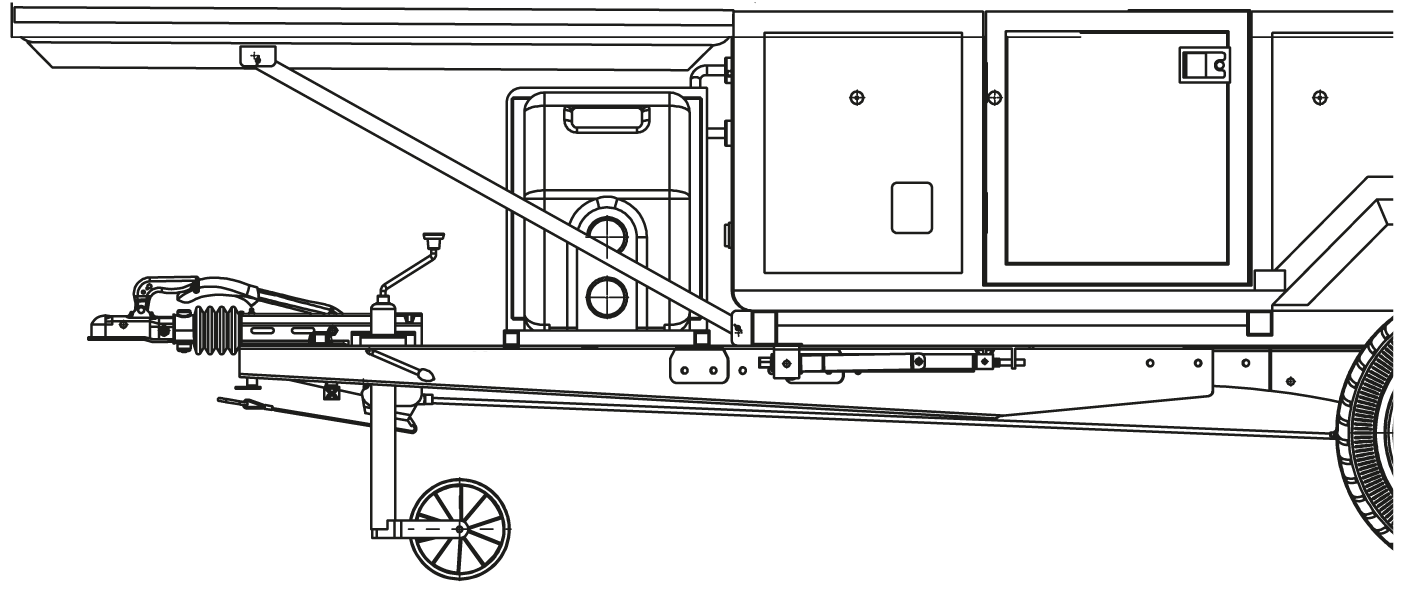

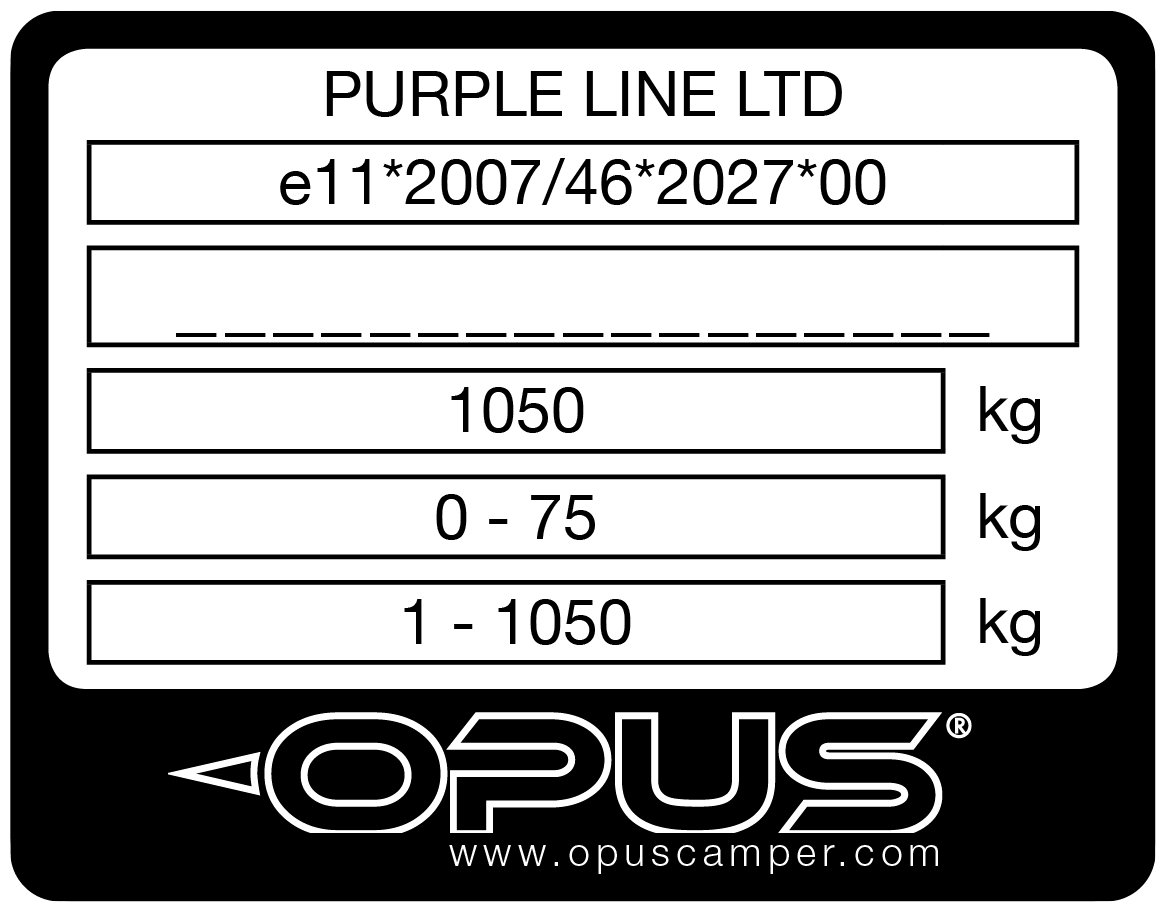

| Dimensions | |
| Overall Length (closed) inc.drawbar | 430cm |
| Overall Width | 201cm |
| Internal Length (main body section) | 283cm |
| Internal Width (main body section) | 188cm |
| Towing Height | 120cm |
| Wheels | 185/70 R13 |
| Overall Length (erected) | 580cm |
| Overall Height (erected) | 275cm |
| Interior Height (max) | 244cm |
| Bed Size 1 | 190cm x 140cm |
| Bed Size 2 | 190cm x 140cm |
| Full Awning Width (optional) | 600cm |
| Full Awning Depth (optional) | 240cm |
| Weights | |
| MIRO (mass in running order) | 840kg |
| MTPLM (Maximum Technical Permissible Laden Mass) | |
| MTPLM – 840kg = User Payload | |
| Roof Payload (approx. depending on roof bar capacity) | 75kg |
| Max Tow Ball Mass (Nose Weight) | 75kg |
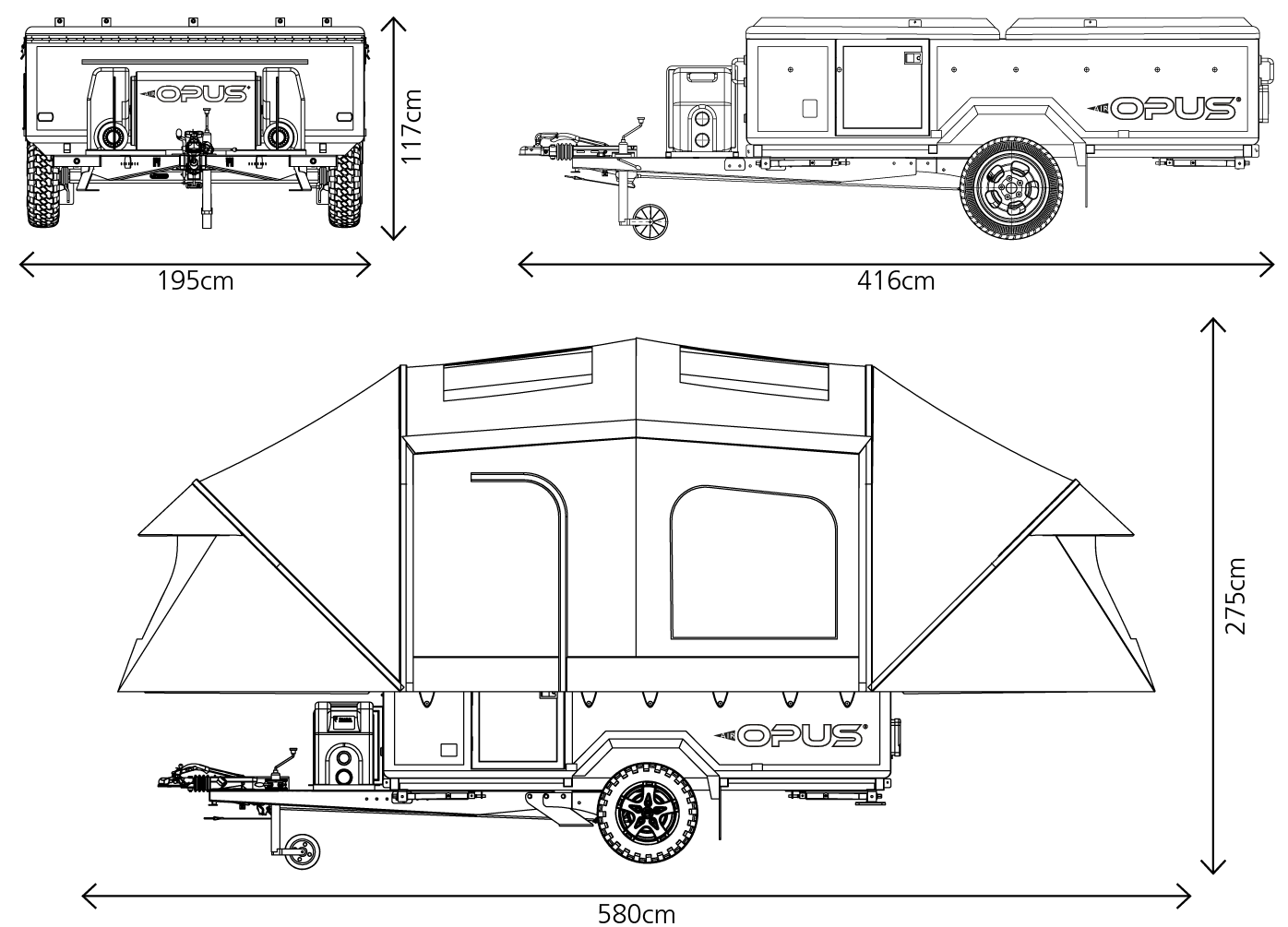

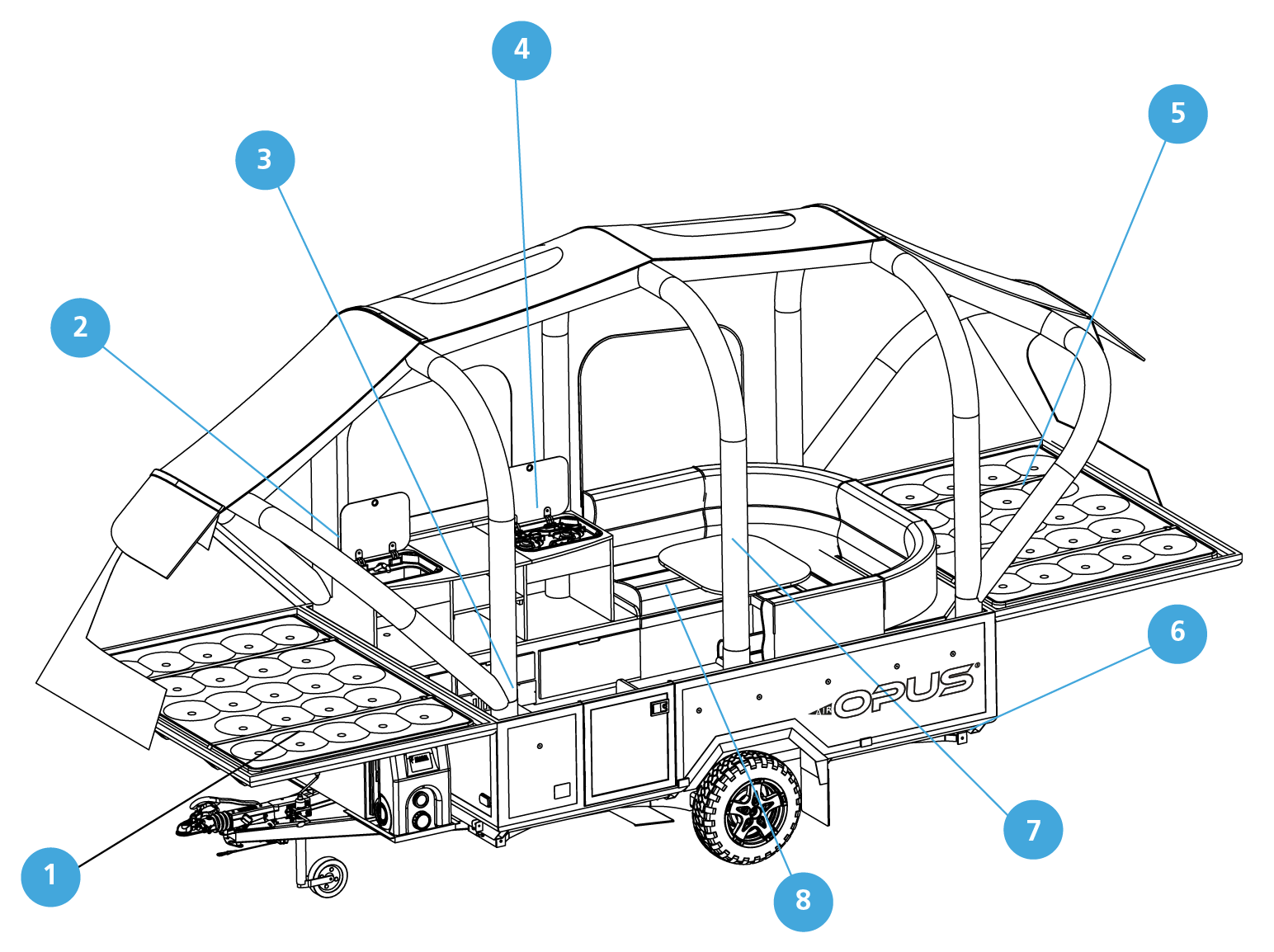

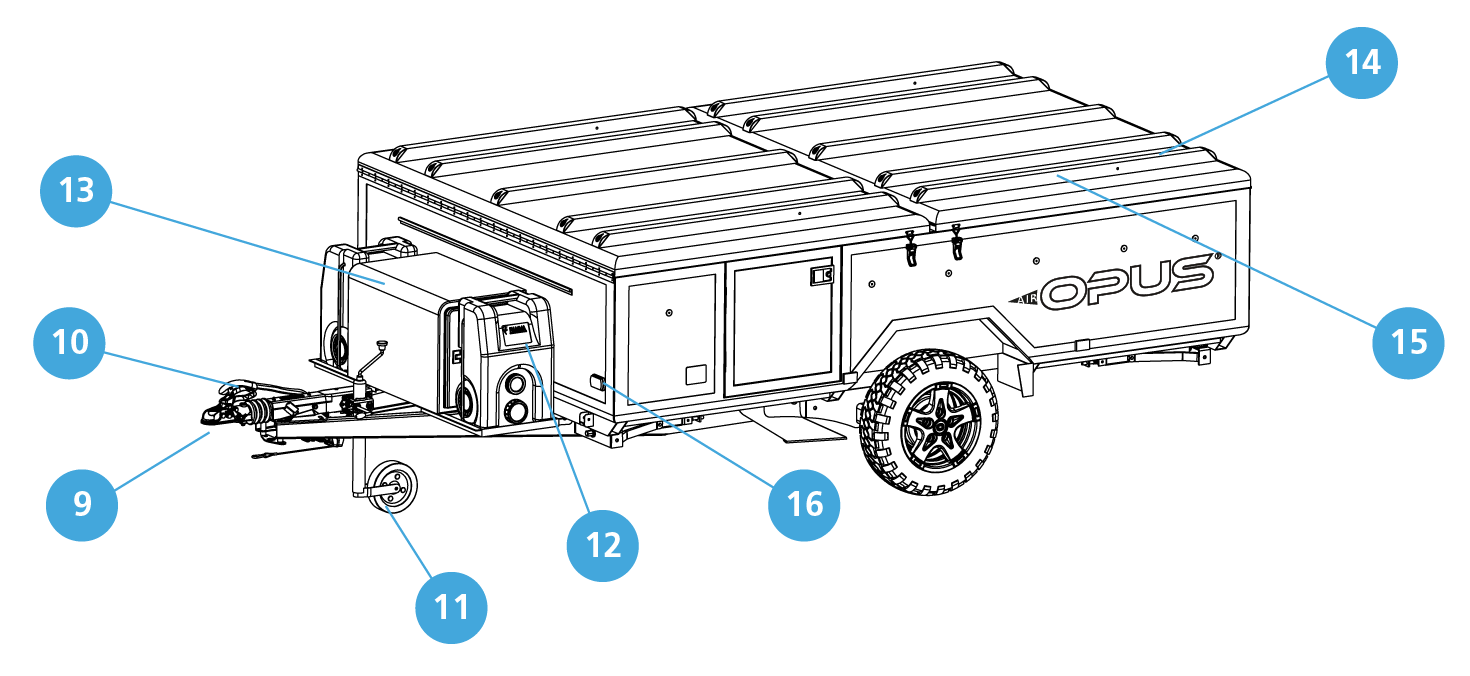

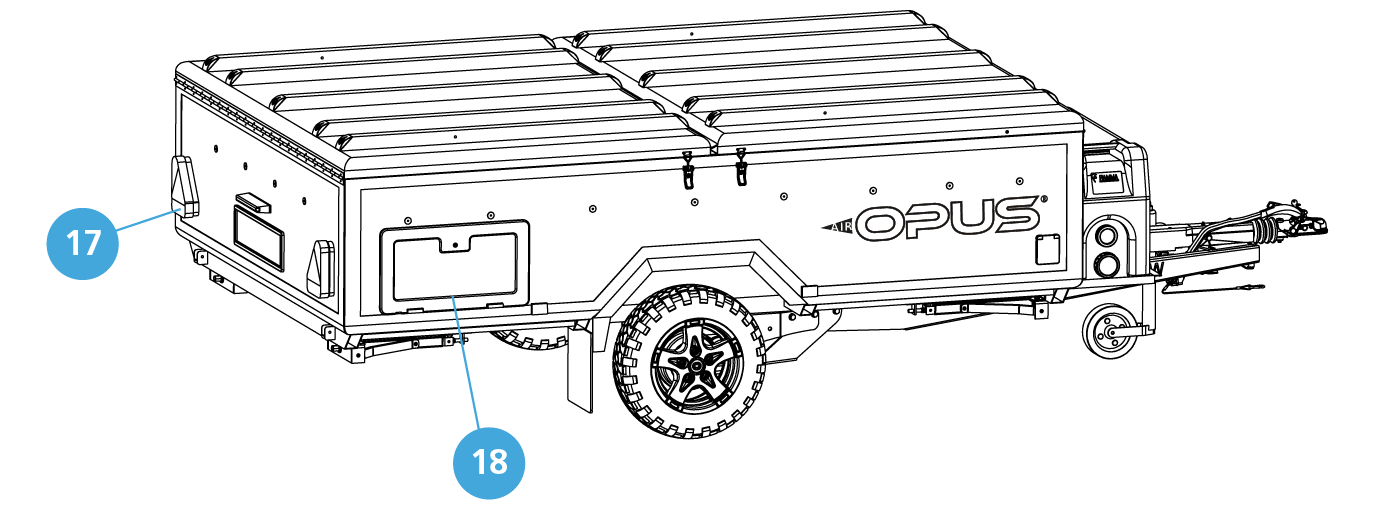

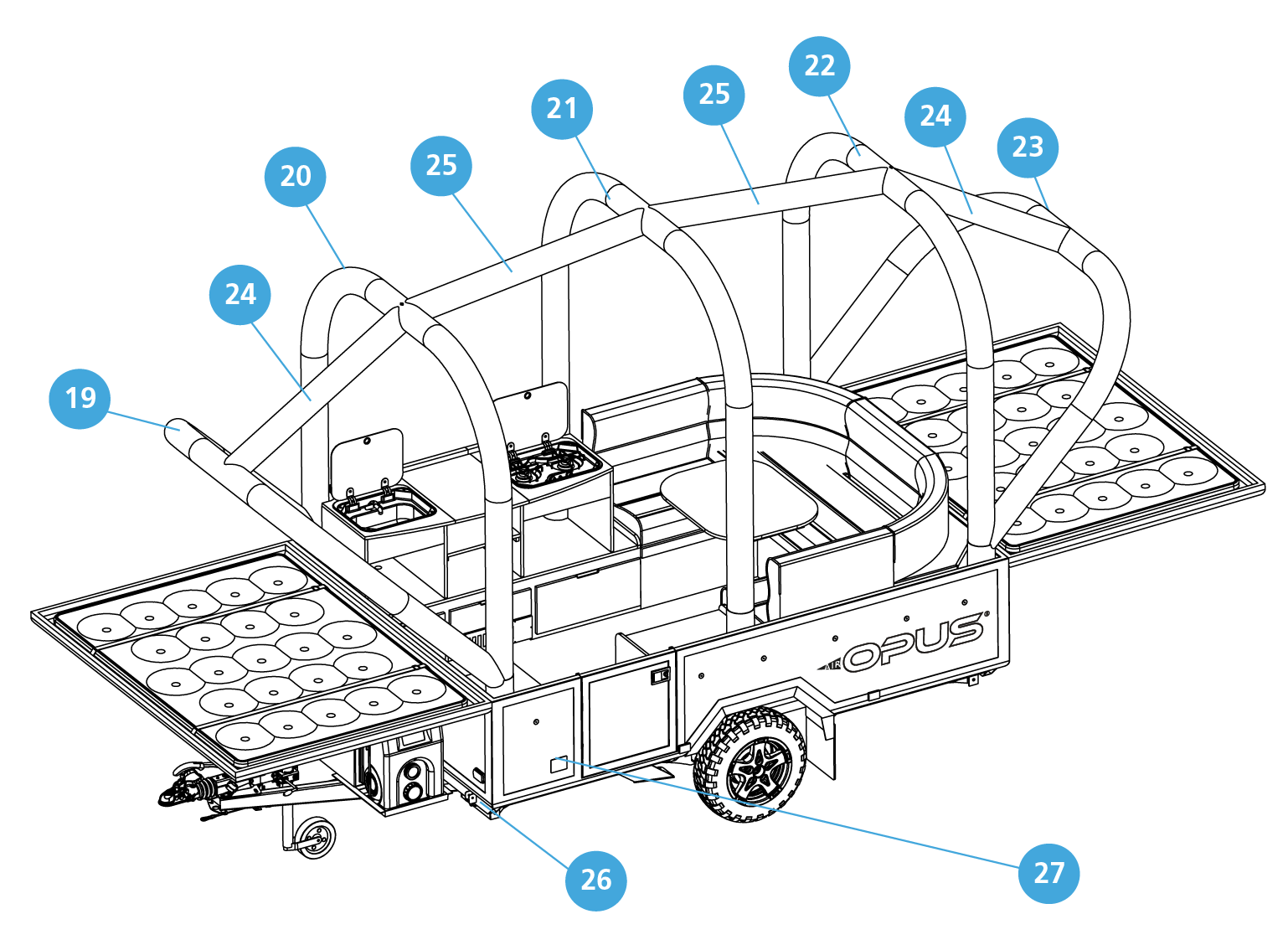

The OPUS® comes as standard with a pressed steel locking coupling suitable for all standard 50mm tow ball fittings.
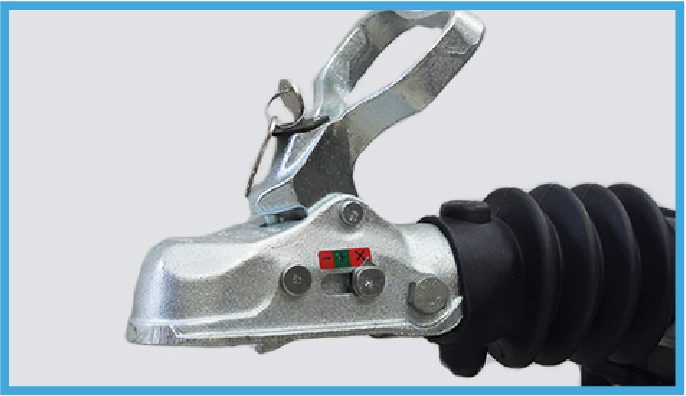

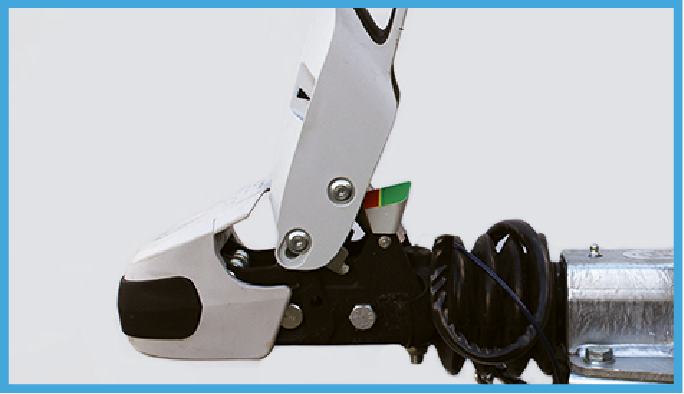

If your OPUS® Camper has the optional Winterhoff 3000 or iSC stabiliser hitching coupling then your tow vehicle should be fitted with either an extended neck flange tow ball or any form of detachable ‘swan-neck’ tow ball would be suitable.
If you have a locking coupling it must be unlocked in transit to enable hitching and unhitching of the Camper.
The Full Stop Saracen Hitch Lock (optional extra) will provide additional security to your Camper.
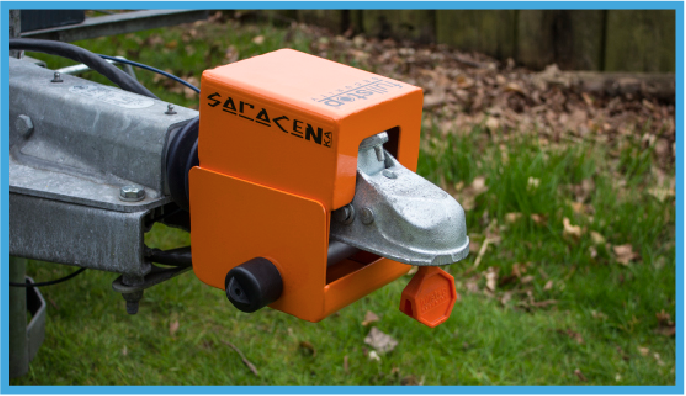

The OPUS® is fitted with a 13-pin plug that connects all the exterior trailer lighting as well as the connections that enable the leisure battery of the OPUS® to be charged by your vehicle whilst in transit. This connection also allows the fridge (optional extra) to operate a cooling function whilst towing using the 12v socket in the cupboard directly underneath the fridge, which is wired directly to the 13-pin plug, bypassing the Camper’s 12v electrical circuit.
A standard black 7-pin socket on your tow vehicle will be suitable to operate the essential running lights by using an adapter (not supplied) that converts the 13-pin plug into a 7-pin type.
However to utilise the features of the 13-pin plug then your vehicle should be fitted with ‘twin’ electrics. These comprise of a black 7-pin and a grey 7-pin socket; an adapter will be required that connects the 13-pin plug of the OPUS® to the twin sockets on your vehicle. Of course, your vehicle may already have one single 13-pin socket that does not require any form of adapter and is the ideal method of connection.
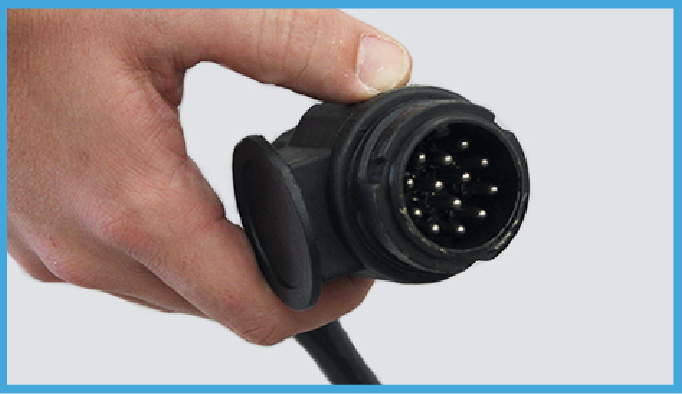

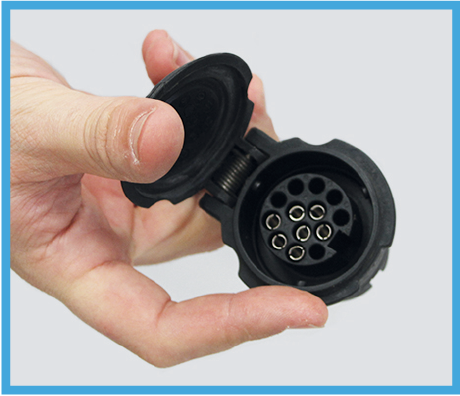

1. When hitching the OPUS® Camper to your vehicles tow ball you must ensure that someone is close to the handbrake in order to maintain control of the trailer, particularly when manoeuvring on a slope.
If you have a locking coupling the coupling will need to be unlocked and the security ball removed (not provided) to perform the step above.
2. Steadily guide the coupling of the OPUS® to the vehicles tow ball. If necessary, raise the front of the OPUS® so that the coupling is higher than the tow ball by turning the handle on the jockey wheel.
Please refer to the separate ALKO guide to the jockey wheel fitted to your OPUS® for safe and correct usage.
The frame of the Camper is designed to aid pushing/handling of the trailer comfortably. The grab handles (optional) may be used to aid manoeuvring but MUST NEVER be used to pull the full weight of the Camper.
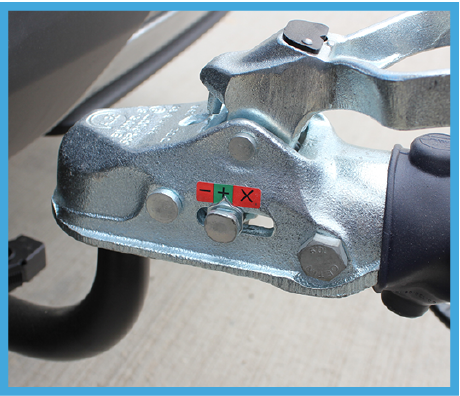

3. Position the coupling over the tow ball and lower it by turning the jockey wheel handle and, at the same time lifting the coupling handle up. When fully engaged onto the ball you will be able to release the coupling handle.
If your trailer is fitted with a stabiliser coupling ensure the handle is engaged into the correct position to use the stabilising feature. The tow ball may also need to be inspected to ensure the stabiliser pad has an adequate grip on the tow ball.
Full instructions on the Winterhoff WS3000/iSC coupling are supplied in a separate manual; please reference the correct and safe use and retain for future reference.
4. Fit the breakaway cable around the neck of the tow ball or through a suitable aperture on the tow bar itself. Ensure it doesn’t foul on the coupling or any other nearby objects such as the trailer lighting cable.
5. Raise the jockey wheel by turning the handle on the top until the wheel engages into the cut grooves on either side of the tube and make sure the wheel is fully tightened. Failure to do this may cause the wheel to retract in transit.
6. Loosen the jockey wheel clamp by turning the handle anti-clockwise and pull the jockey wheel up to provide the maximum ground clearance ensuring the wheel is pointing towards the rear of the OPUS®. Tighten the jockey wheel clamp.
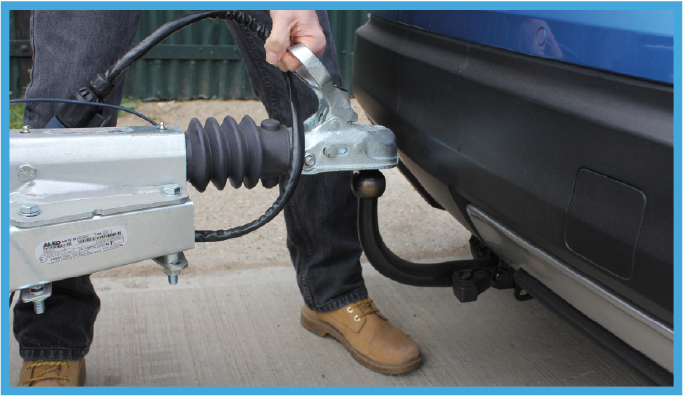

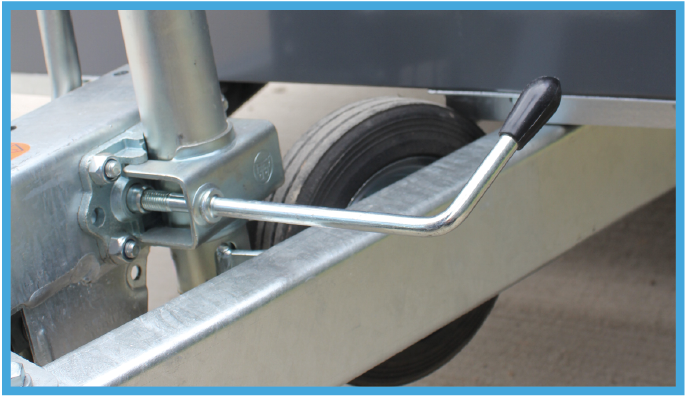

7. Connect the 13-pin plug into the socket (using adapter your if required) on your tow vehicle.
8. Release the handbrake if still engaged.
9. Before any journey you must check that all the trailer lights are functioning correctly.
Check front marker, side, brake, reverse and warning lights as well as both directional indicators.
Engage the handbrake. Release and secure the jockey wheel and tube to a lower position, wind the jockey wheel down until it touches the floor and starts to support the weight of the Camper. Some weight relief on the tow ball will be observed. The handle of the coupling can be lifted to release the coupling from the tow ball. Continue to wind the jockey wheel until the coupling is clear of the tow ball. Then disconnect the 13-pin plug and the breakaway cable.
When you are ready disengage the handbrake; the trailer can now be manoeuvred separately from the tow vehicle.
It is the responsibility of the driver of the tow vehicle to ensure that any loads, such as bicycles, roof boxes, kayaks, etc. are suitably secure prior to transit.
The Maximum Technically Permissible Laden Mass (MTPLM) must not be exceeded under any circumstances.
Items loaded onto the top of the OPUS® should be mounted so that the heaviest items are towards the front of the Camper.
The OPUS® will accept suitable/recommended roof bars that are designed to fit onto longitudinal roof rails. Ensure that any roof bar is securely fitted onto the square aluminium ribs on top of the Camper. The lip of the roof bar foot must be located underneath the channel and then securely clamped onto the square roof ribs.
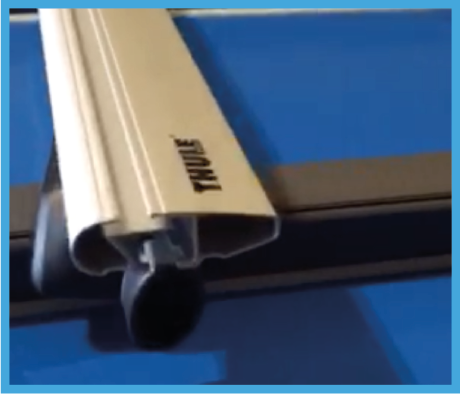

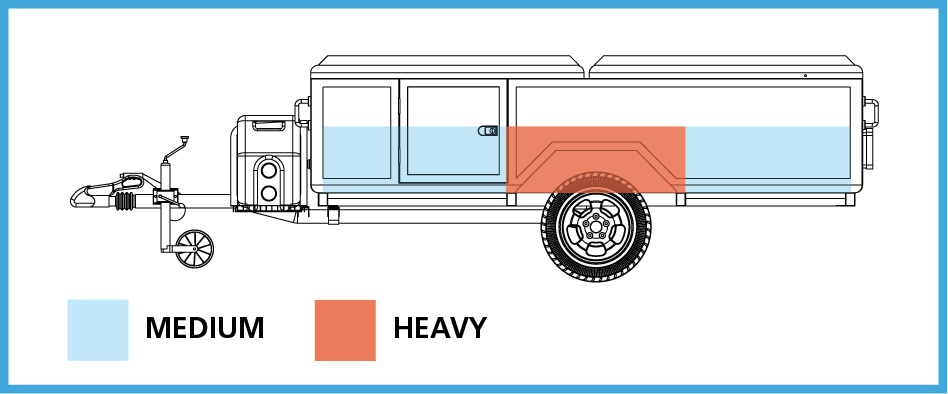

If only one set of roof bars are installed then the load should be situated on the front bed tray lid, where possible. If a roof box is fitted it should be mounted on the rear bed tray lid so that it can remain in position when the camper is opened out. Ensure that the weight and balance of the trailer loading is maintained when using a roof box on the rear of the trailer to avoid adverse effect on the handling of the trailer. Always ensure you do not exceed the maximum loading capacity of any carrier, roof box or the roof bars. Further information can be found in the Roof Load Carrying section.
The driver of the tow vehicle must ensure that their Driving Licence is valid for towing the OPUS® Camper. Please refer to the following website address for reference: www.gov.uk/towing-with-car
It is highly recommended, particularly if you are not experienced in towing that you adhere to any applicable laws for the country in which you are driving. Many guides are available from leading associations and should be studied before you embark:


The Camping and Caravanning Club
www.campingandcaravanningclub.co.uk
0845 130 7631


National Trailer & Towing Association
www.ntta.co.uk
01909 512555
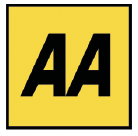

The AA
www.theaa.com
PLEASE ENSURE YOUR AIR OPUS HAS BEEN ‘WEATHERED’ BEFORE FIRST USE. PLEASE REFER TO THE WEATHERING SECTION FOR DETAILS
Try to choose a site that is relatively flat. Avoid sites where the land may flood or where water will run down. DO NOT pitch directly under trees. Pitching near a hedge or wall may provide shelter against wind. AVOID areas with heavy pollution and where crop spraying may be in progress.
1. Once you have your OPUS® in position then you must engage the handbrake.
DO NOT ENTER THE OPUS® UNTIL THE CORNER STEADIES HAVE BEEN LOWERED INTO THE CORRECT POSITION.
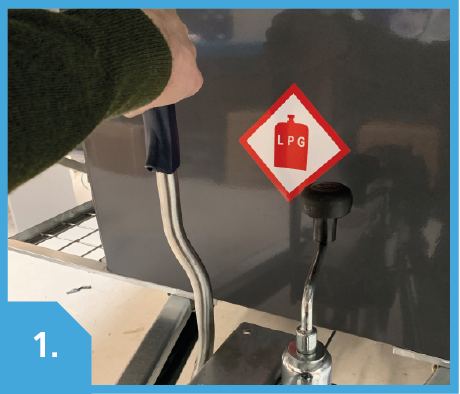

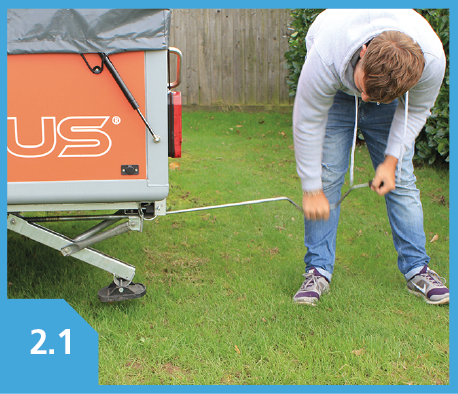

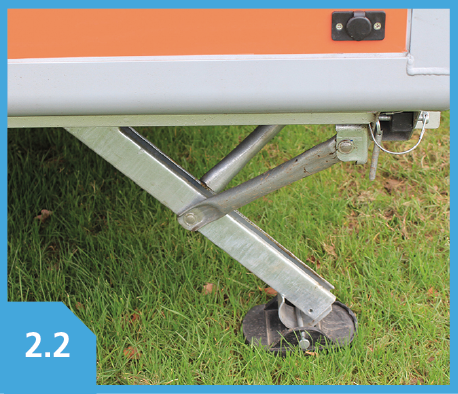

2. Raise or lower the jockey wheel to level your OPUS® lengthways. Using the included corner steady winder (or cordless drill/driver with a 19mm hex socket attachment) wind down each corner steady leg until it touches the ground. Depending on the terrain, you may need to adjust each corner to level the OPUS® widthways. KoPads (corner steady feet) are available as an accessory that clip onto the base of each corner steady to spread the load of the leg and enable a sure footing, reducing the risk of sinking into softer ground.
3. Once satisfied that the OPUS® is stable and level, you need to fit the four bed tray support legs. The legs are interchangeable and any leg can be fitted to any of the brackets. The legs are stored in each corner within the frame and are accessible by unclipping the D-pin clip and sliding them out.
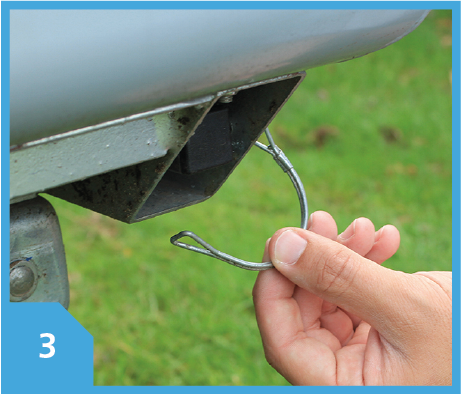

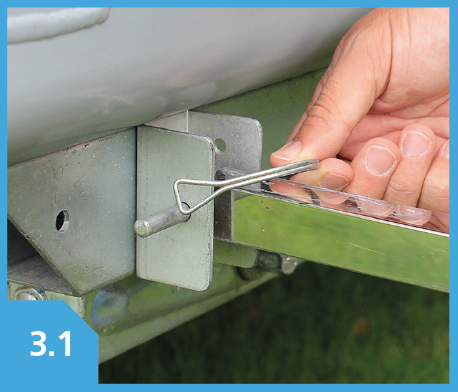

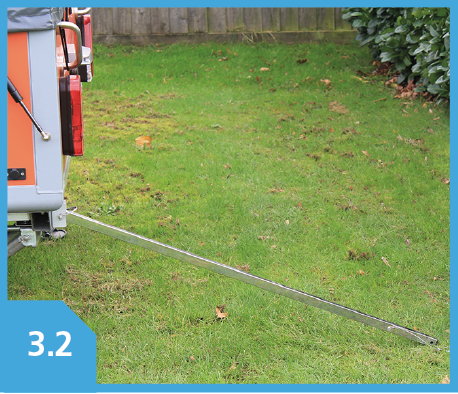

Each leg has a retained pull pin on one end; the end without the pull pin should be inserted into the lower bracket on the frame of the Camper. The D-pin is then used to secure the leg onto the bracket. Insert the pin through the bracket and leg holes and secure it with the clip. For the moment the other end of the bed leg can rest on the ground. Repeat this procedure for the three remaining legs.
4. If applicable unstrap your water and waste carriers and place them beneath the trailer near their respective outlets. Also, access the gas locker and turn on the gas bottle if applicable.
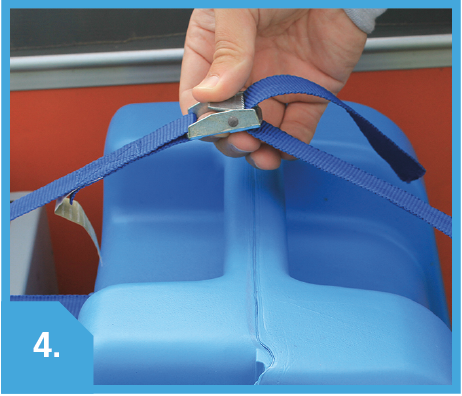

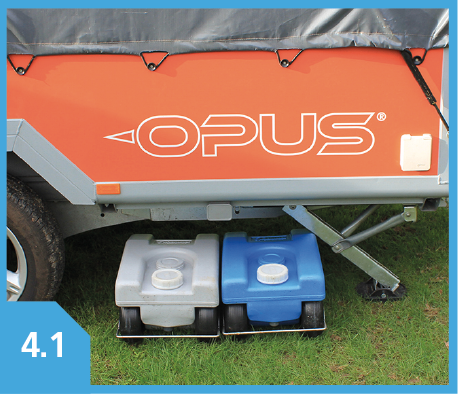

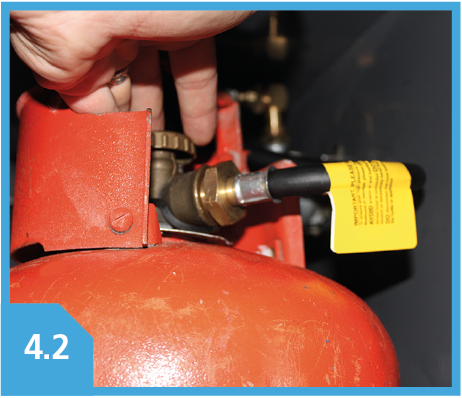

5. Release the four clamps that secure the lids of the OPUS®.
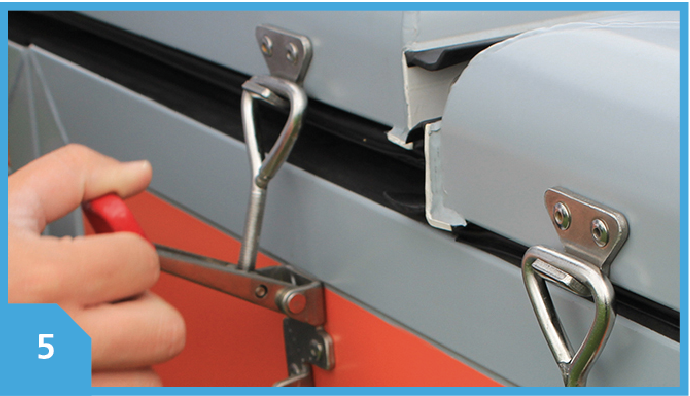

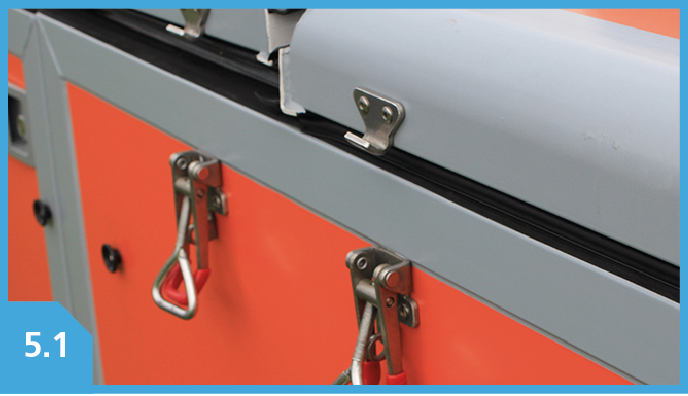

6. Open the front lid through 180°, gas struts are fitted to aid the process and support the weight of the lid at this stage.
7. Open the rear lid through 180°.
8. At this stage walk around the OPUS® and inspect the tent to ensure that the canvas is properly located within the aluminium channels and that no part of the tent is caught or snagged.
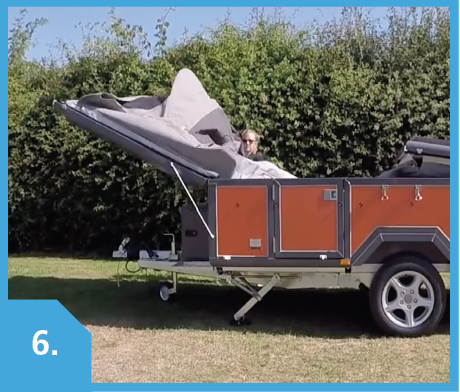

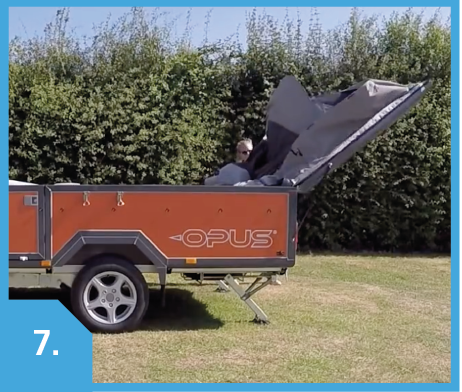

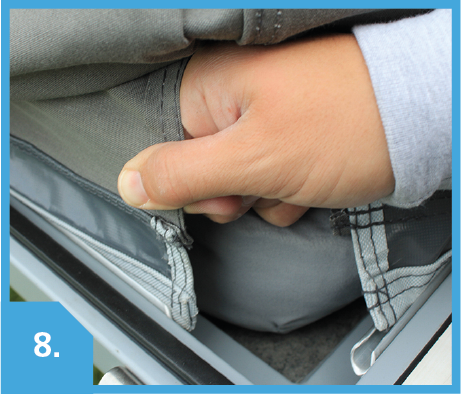

9. Lift up the ends of each bed support leg into the corresponding bracket on the now unfolded lids, line up the holes and insert the pull pin. Ensure all pins are fully inserted. You may find it easier to move the lid during this process to aid aligning the holes.
OPEN THE DOOR FULLY AND ‘LOCK’ IN TO THE PLASTIC RETAINING CLIP AGAINST THE TRAILER. DO NOT USE THE DOOR AS AN AID FOR ENTERING OR EXITING AS THIS COULD EVENTUALLY COMPROMISE THE DOOR SEAL.
10. At this point, especially if this is your first time at opening the Camper please note how the interior has been packed away to enable the lids of the Camper to be closed ready for transit and storage. It may be useful for you to take a photograph of the packed down interior to help ensure you get the OPUS® packed down correctly and efficiently.
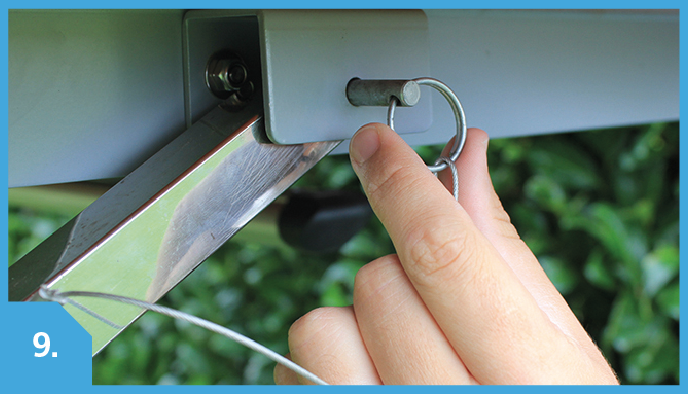

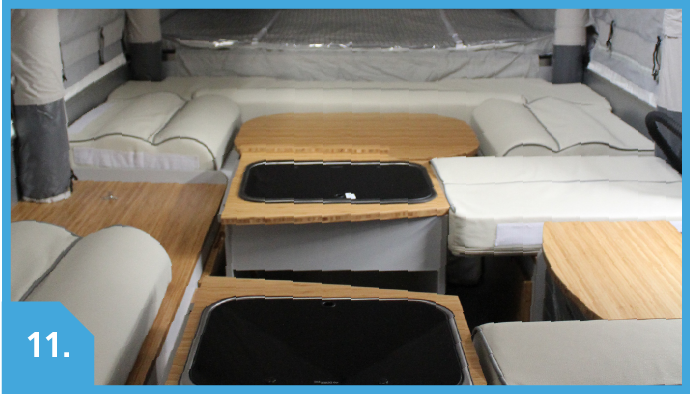

PLEASE ENSURE THE AIR TENT DOOR AND WINDOWS ARE CLOSED BEFORE TENSIONING THE TENT.
1. Open the AIR OPUS® trailer door and locate the pump switch within the electrics panel.
2. Ensure the 12v system is turned on.
3. Ensure all the external AIR valves are closed to allow for inflation and ensure all internal valves are open.
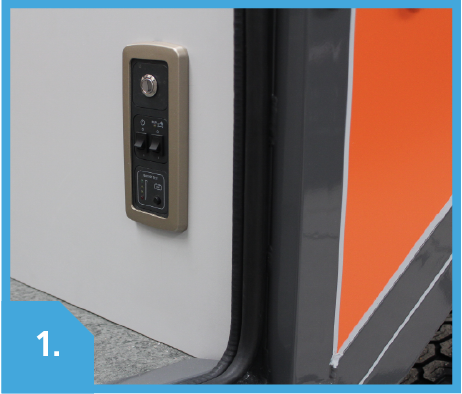

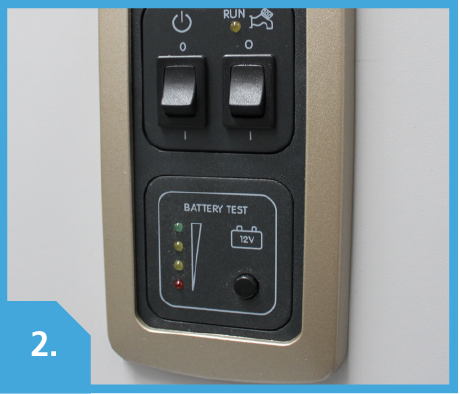

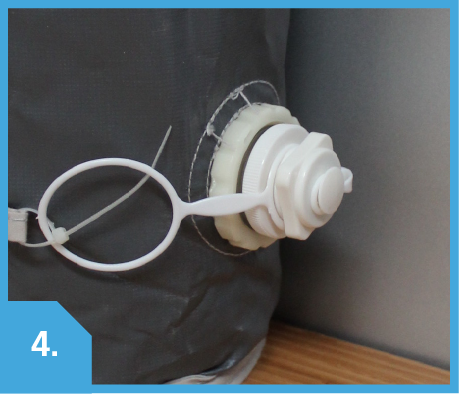

4 .The white valve in your AIR OPUS® Tent is your master valve. This valve is located on the centre AIR beam, positioned behind the fridge. Insert flexible pump hose into the white valve until tight.
5. Press the pump switch to begin inflation.
6. AIR OPUS® inflatable tubes need 8psi of pressure to give a rigid support. Your AIR OPUS® tent is supplied with a built in electric pump with an attached hose (to attach to the white valve) which is pre-set to inflate to 8psi and stop automatically on completion .
YOUR PUMP IS SET TO INFLATE ONLY. DO NOT TAMPER WITH THE PUMP AND DO NOT ATTEMPT TO USE THE PUMP TO DEFLATE YOUR AIR OPUS®.
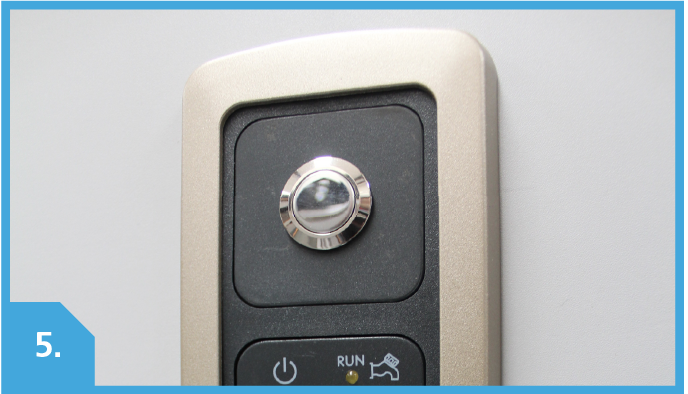

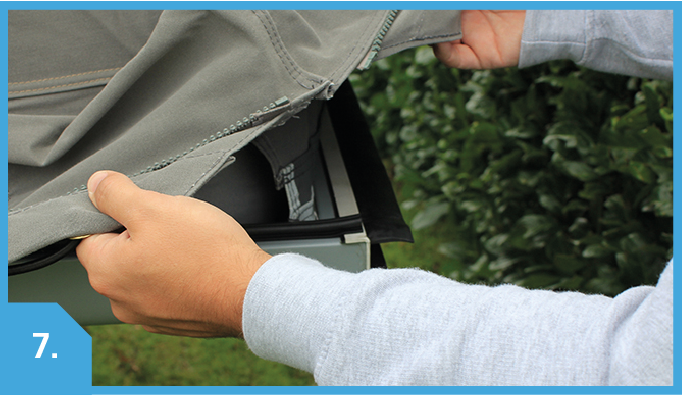

7. Secure the tent canvas over the bed ends as the AIR tent inflates.
8. Once fully inflated to the correct pressure the pump will automatically cut out.
9. Release pump hose and replace white screw cap (failure to do this will cause gradual deflation).
10. Remove the internal items of your OPUS and lay outside in a suitable area, in order to gain access to the inner bed tents, or facilitate the roof lining fitting or adjustment of roof windows or blinds.
11. Attach inner bed tents to internal fixings at both bed ends.
12. (If applicable) Install LED lighting into zipped PVC pockets on AIR tent roof beam, route cabling through AIR pole sleeving down to socket and connect. Once installed the LED lighting can stay fitted permanently, but it must be disconnected from the socket before pack down.
13. If you haven’t done so already lift the gas hob unit and the sink unit onto the kitchen base platform to clear floor space.
14. If you haven’t done so already, the top-loading fridge can now be placed on top of the unit next to the door to clear floor space.
15. Walking around the Camper the elastic bungee that is within the tent can now be fitted over the corresponding button cleats. The tent should now be fully tensioned.
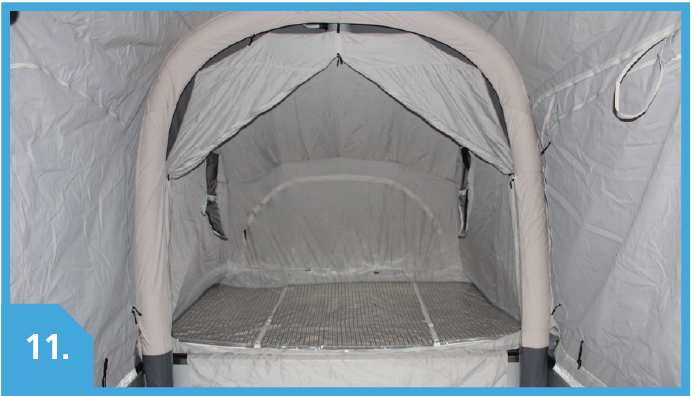

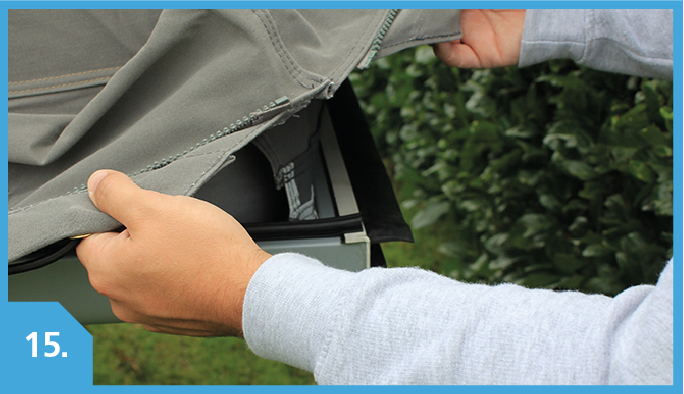

PLEASE ENSURE THAT YOU ROLL ALL SIDE WINDOWS, ROOF WINDOWS AND DOORS SO THAT THE INTERIOR SIDE OF THE MATERIAL IS NOT EXPOSED I.E ROLL THE FABRIC INWARDS. YOUR FABRIC HAS A COATING ON THE INTERIOR WHICH MAY BE DAMAGED OR CHANGE COLOUR IF EXPOSED TO UV FOR A PERIOD OF TIME.


1. Position the hob unit onto the kitchen base unit so that the unit sits either side of the two clips built into the base platform. Secure the unit to the platform using the clips.
2. Position the sink unit onto the kitchen base unit so that the left hand side is against the front wall of the Camper; the cut-out corner of the unit should sit around the AIR column.
3. Locate the lower middle shelf onto the battens on the side of the sink and hob units; there are small metal studs protruding from the battens to secure this in place, a light pressure maybe required to properly sit the shelf onto the studs.
4. Fit the top middle shelf section of the kitchen worktop and secure it in the same manner using the studs.
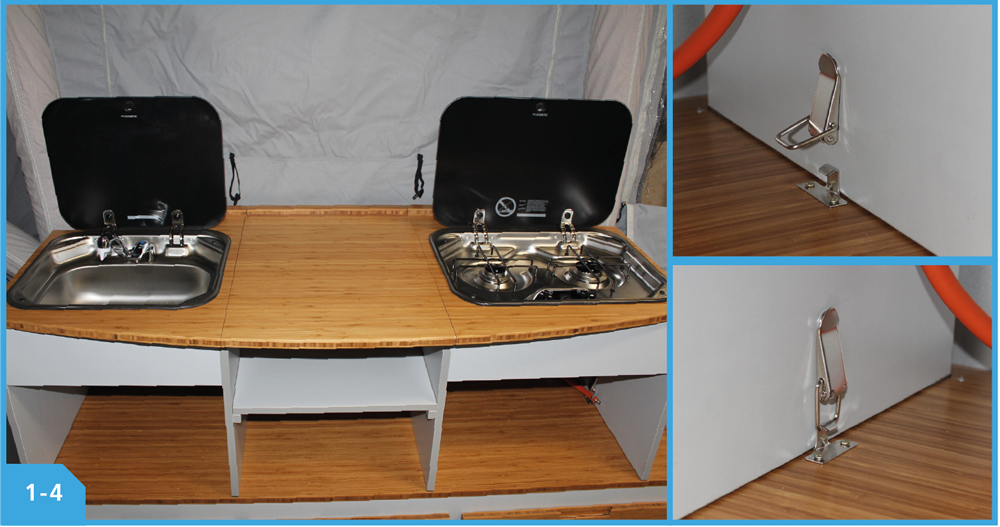

AIR OPUS® COMPLETE KITCHEN. CLIPS TO SECURE UNITS.
5. Fit the waste water outlet hose (grey) underneath the sink unit into the waste water aperture on the kitchen base unit.
6. Pull up the fresh water feed pipe (green) from the base unit and connect to the fresh water hose underneath the sink unit. The connection is made with the aid of a male to male coupler which can be retained on either side of the connection depending on the side disconnected.
7. Feed the gas hose (orange) underneath the hob unit through the aperture in the top of the kitchen base unit.
8. Open the front locker door below the cooker unit and connect the gas hose into the gas coupling. This also serves as the on/off valve.
9. Turn the red gas tap at the connection through 90° to turn on the gas supply to the hob.
FOR SAFETY REASONS THE GAS HOSE CANNOT BE DISCONNECTED FROM THE GAS VALVE WHILST THE GAS SUPPLY IS STILL TURNED ON.
For the initial use of the hob after connecting to the gas supply, it will take a few seconds for the gas flow to reach the gas hob burner.
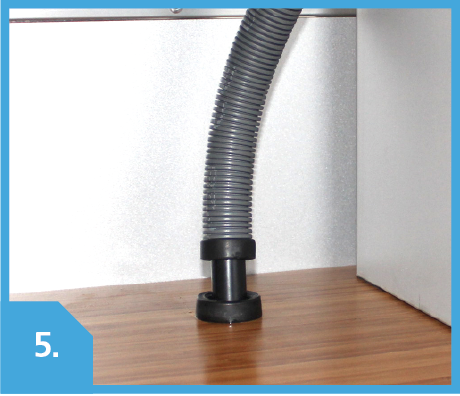

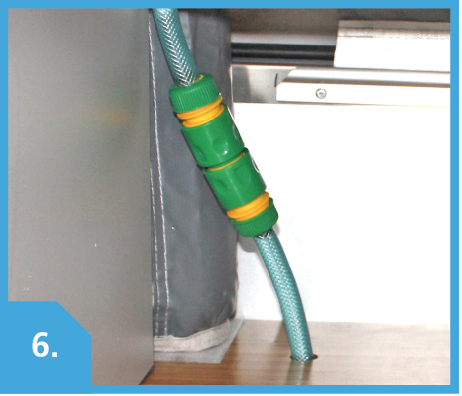

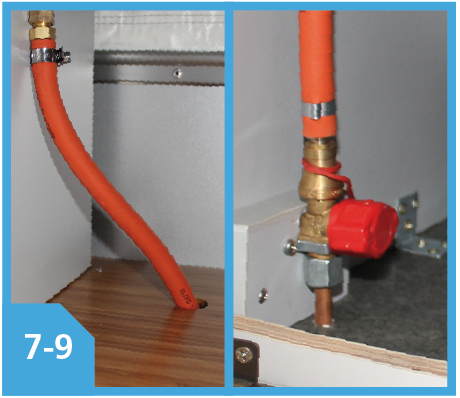

10. If applicable, slide the microwave oven underneath the gas hob unit and feed the power cable around the back of the unit to the power socket.
11. If not already done so position the fridge on the base unit located between the door and the club lounge.
12. A socket cover aperture is provided in order to feed the mains and 12v cables/plugs through into the base unit.
13. Plug the 3-pin mains plug into the mains socket provided in the unit, this can be accessed from the lift-top locker door.
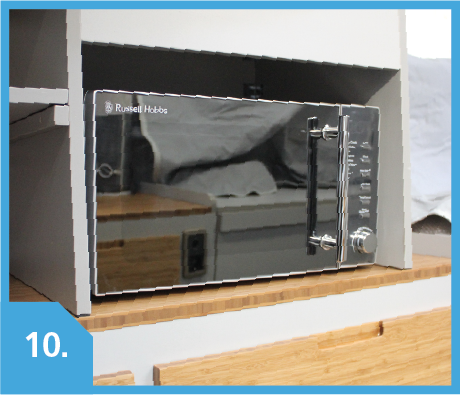

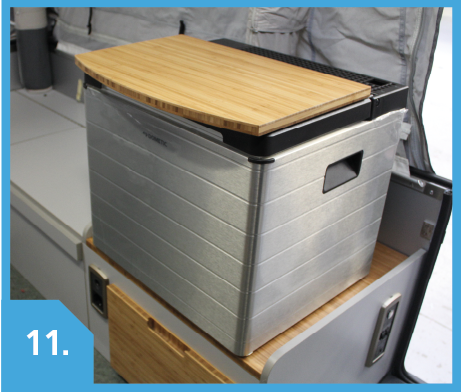

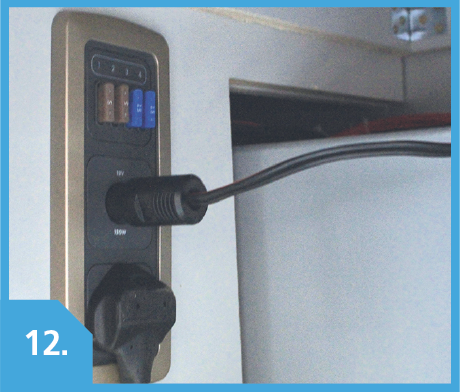

THE 12v SOCKET LOCATED INSIDE THIS UNIT ONLY POWERS THE FRIDGE WHEN IN TRANSIT IF THE TOW VEHICLE IS UTILISING THE 13-PIN (OR TWIN 7-PIN) SOCKETS. THIS 12v SOCKET IS ONLY POWERED WHILST THE TOW VEHICLE’S ENGINE IS RUNNING AND DOES NOT OPERATE OR PROVIDE POWER WHEN THE CAMPER IS DISCONNECTED FROM A RUNNING VEHICLE AND IS ONLY FOR USE AS A FRIDGE SOCKET.
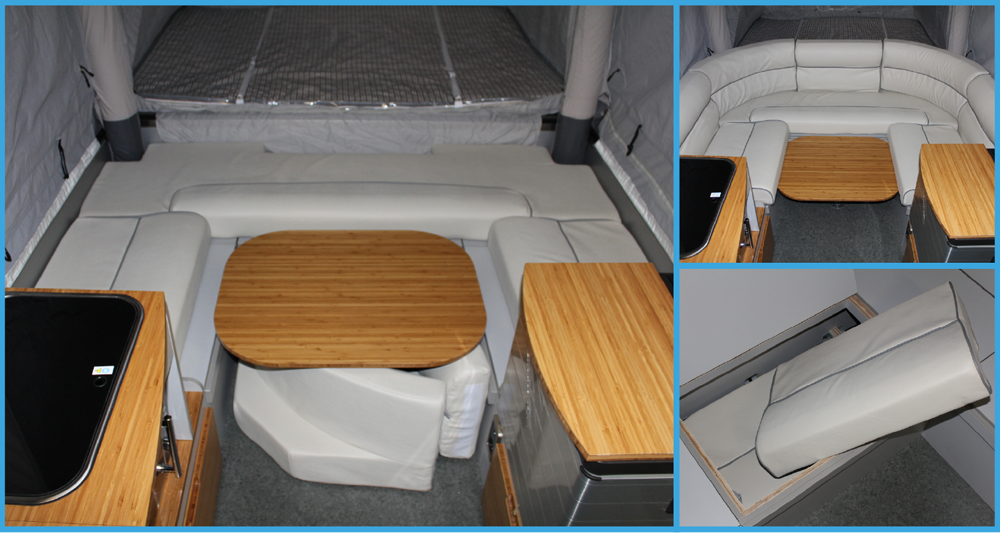

CLUB LOUNGE/SEATING AREA PACKED DOWN
1. Place the table out of the way to start with – this can be left on either bed.
2. Locate all seat cushions (soft backs), and then locate the Velcro fitted to each type of back cushion (hard backs) to help you understand where each cushion goes.
3. The three seat bases are positioned as above (cushion numbers 1,2 & 3) fit the back cushions with the Velcro on both sides into the void of the long seat base – cushion number 6.
4. The corner cushions can now be positioned and attached to the rear seat back with the Velcro – cushion numbers 5 & 7.
5. The other two seat backs should be placed at their respective sides with the Velcro sides facing towards the rest of the cushions (rear of the Camper) and attached to the corner cushions. Cushion numbers 4 & 8 from the middle cupboard.
6. Fit the table leg into the aperture located in the floor of the Camper.
7. Locate the table socket on the underside of the table and place it over the top of the table leg. Firm pressure on the table centre will set the table and table leg securely for use.
The main set-up of the Camper is now complete. The water, gas and electric systems sections detail the use and function of the individual components.
The seating area inside the OPUS® can be reconfigured to provide an additional bed, please see diagrams for reference.
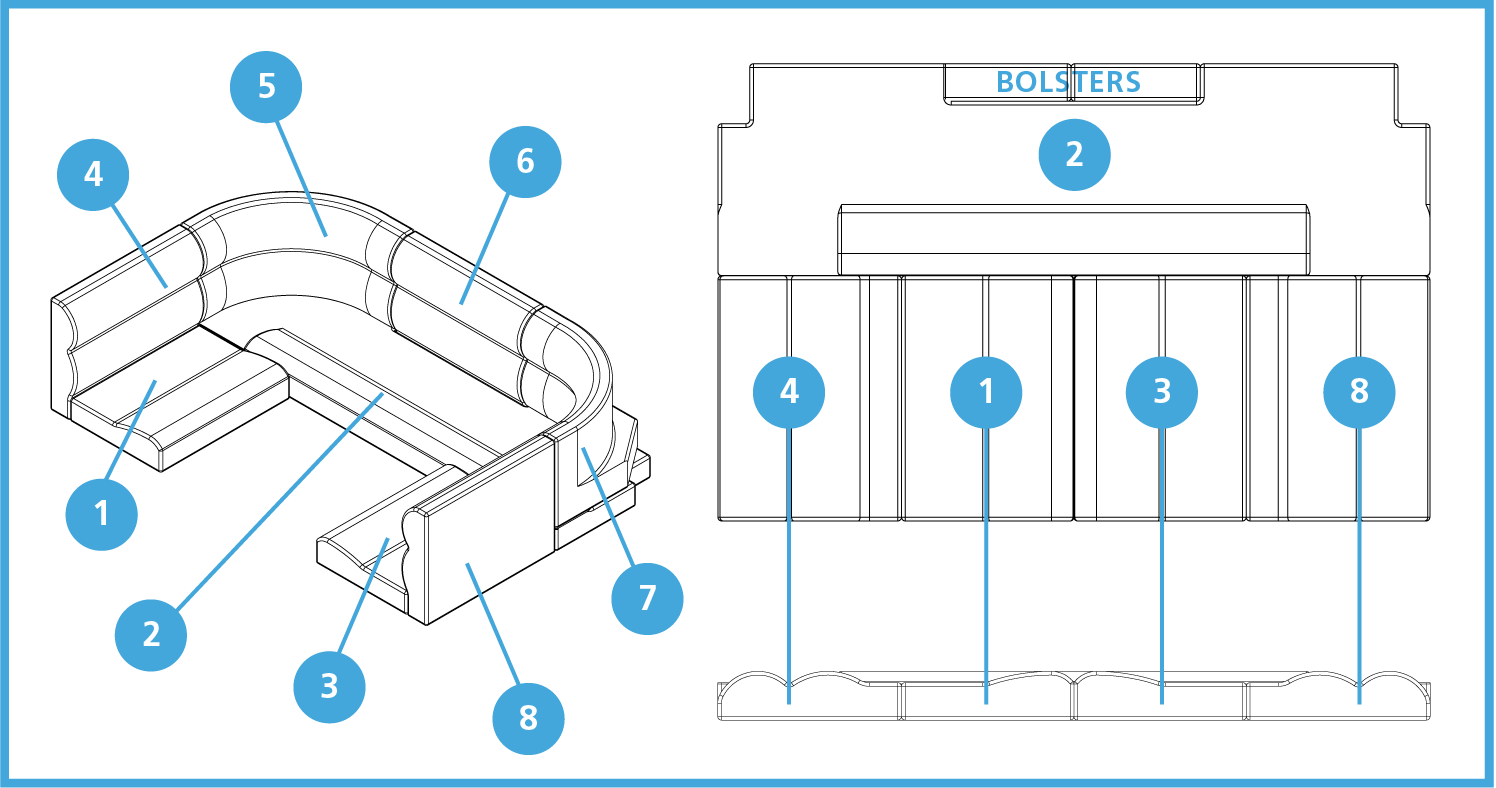

CLUB LOUNGE/SEATING AREA ASSEMBLED. CONVERTED TO ADDITIONAL BED.
The furniture of the Camper with the inclusion of the table forms the base of the additional bed; the table is reinforced to provide adequate support for sleeping. The images below are for guidance.
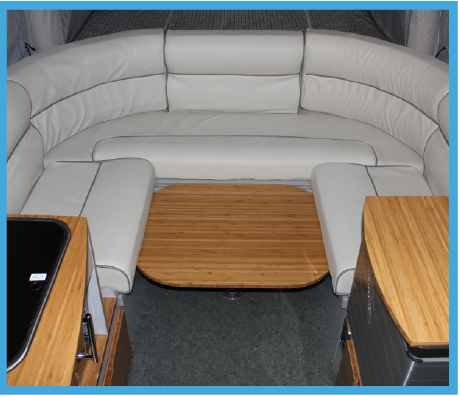

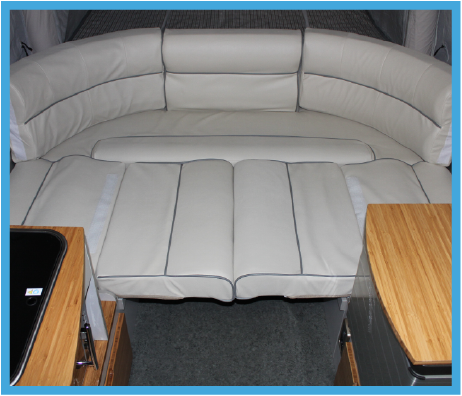

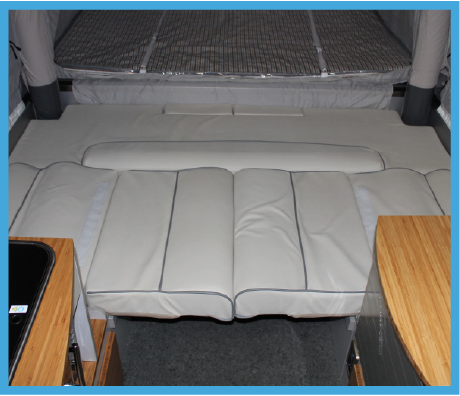

1. Firstly position the table top in the position shown above to form the base section of the additional bed.
2. Arrange the cushions as shown above. Cushions 5,6 & 7 are not required for the additional bed and can be removed.
3. The two bolster cushions fit into cushion number 2 – where cushion number 6 would usually sit. Then position cushion 4 to the far left, followed by cushions 1,3 & 8 to form the bed.
REFER TO THE CONDENSATION AND VENTILATION SECTION
IMPORTANT! A LEISURE BATTERY OR MAINS HOOK UP CONNECTION IS REQUIRED TO OPERATE THE WATER PUMP.
1. The OPUS® has been designed to accommodate Fiamma 23L drinking (blue) water container and waste (grey) water container.
These containers are optional extras; the instructions for the water system will be based on these. If you haven’t chosen these options or are using alternative carriers, please follow these instructions in addition to your desired carriers instructions where applicable to set up the water system.
2. To set up the water system, the blue fresh water container should be filled up from a suitable source then positioned just below the Camper’s water inlet as shown.
3. Lift up the water inlet cover and connect the hose/pump plug into the socket cover as this retains the plug in position. Insert the submersible 12V pump into the water container ensuring the opening is protected from debris and unwanted particles by inverting the cap attached to the pump and fitting it inside the open screw-on ring of the water tank.
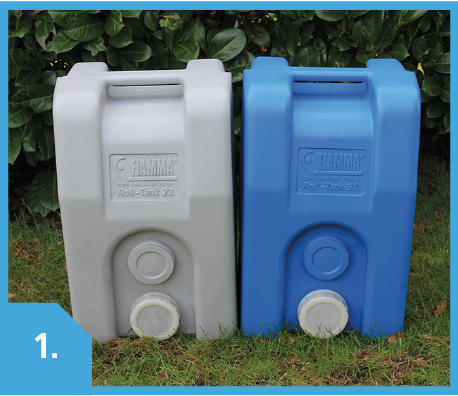

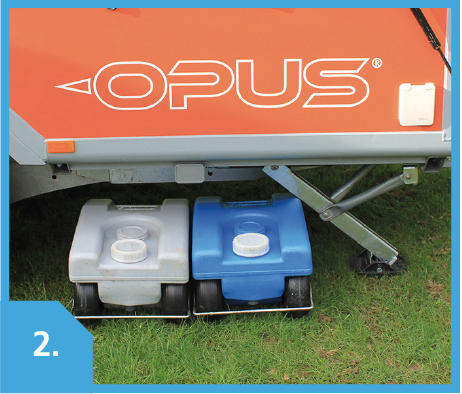

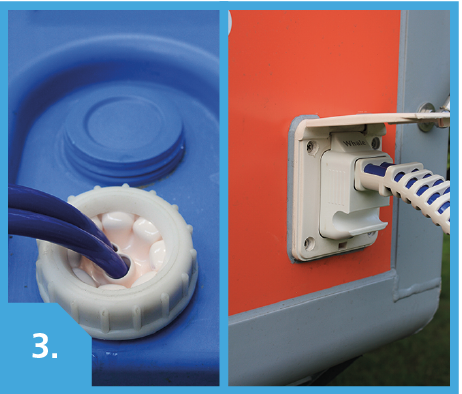

4. Position the grey waste water container just below the waste water outlet. Connect the grey convoluted hose into the outlet on the Camper and the other end into the waste container.
5. To activate the pump, turn on the main power switch and also turn on the pump switch (marked with a tap symbol and the word ‘RUN’).
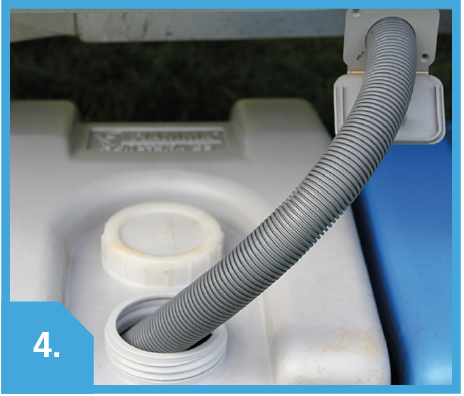

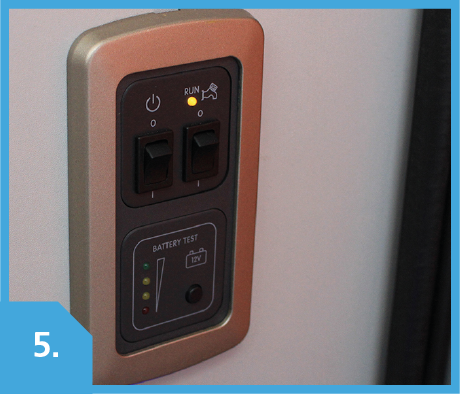

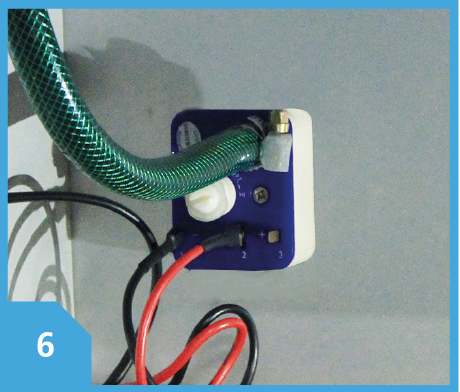

6. To adjust the flow/pressure of the water pump: a plastic screw can be found in the cupboard underneath the sink unit, on the back of the female pump connector. Turn clockwise to increase flow/pressure and anti-clockwise to reduce flow/pressure.
7. To operate the pump, simply lift up the tap lever in the sink. The inlet socket has a pressure switch that automatically operates the pump when the tap is opened. It may take a few seconds for the water to run steady – due to air in the pipes.
8. When packing away the OPUS® you must adhere to the following procedure in order to drain the system of any excess water before disconnecting the internal water inlet and internal waste pipe:
A. Switch off the pump at the mains power switch.
B. Open the tap and allow the excess water in the pipe to drain.
C. Close the tap once all of the water has drained.
D. Disconnect either side of the male to male hose coupler.
E. Disconnect the bottom waste water outlet pipe.
F. The waste water outlet pipe can be secured underneath the sink unit.
G. The male to male hose coupler can be left on either of the hoses when disconnected.
H. Store the external submersible pump and external waste pipe fitting inside the sink.
I. Close the glass lid.
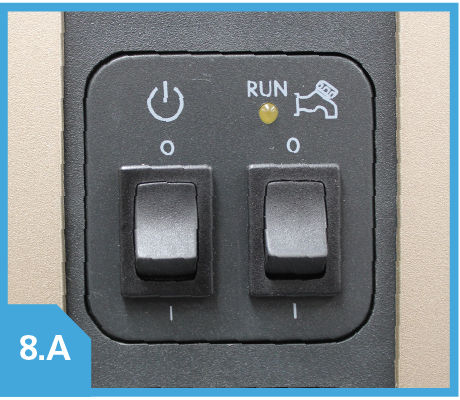

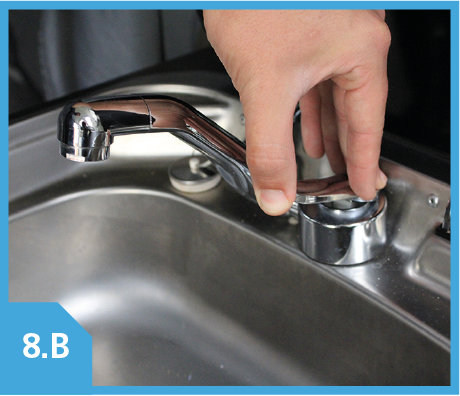

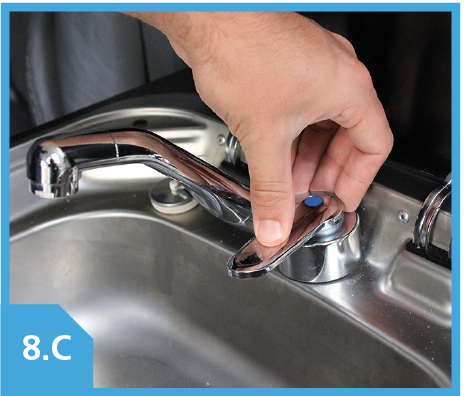

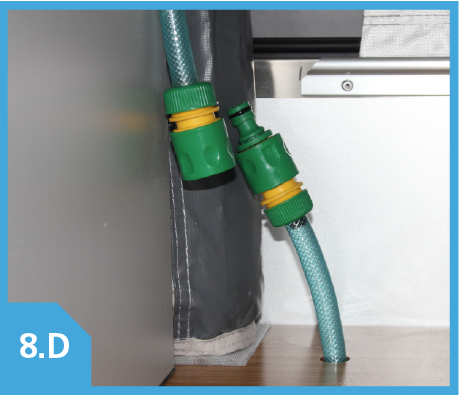

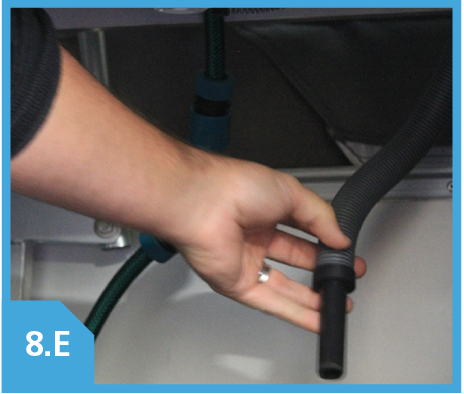

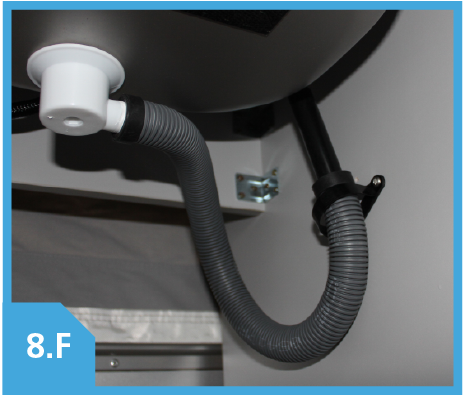

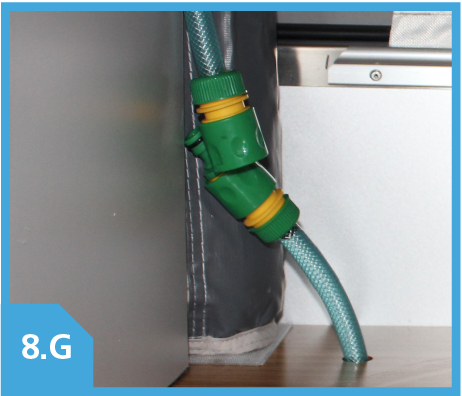

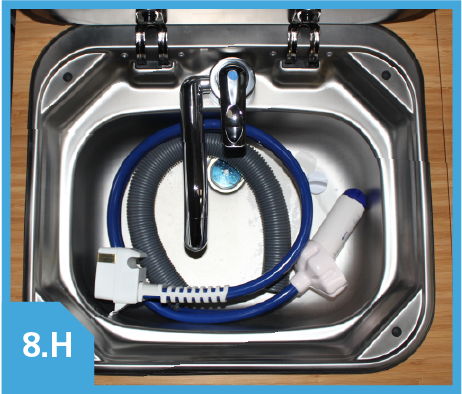

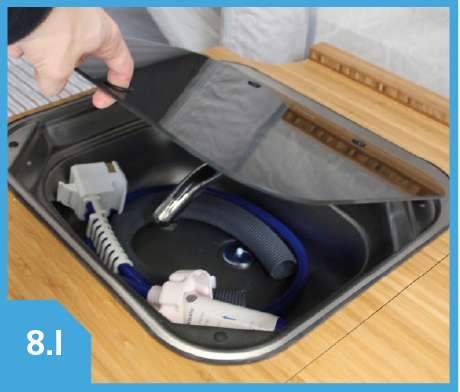

A SMALL AMOUNT OF WATER MAY BE PRESENT FROM THE CONNECTORS AND WASTE HOSE, SO A CLOTH IS USEFUL TO REMOVE ANY EXCESS WATER.
1. The OPUS® has the facility to carry 2 x 4.5kg Butane or 2 x 3.9kg Propane gas cylinders (not supplied) in the front gas locker compartment. The OPUS® is fitted with straps for one gas cylinder as standard. Please contact OPUS® to upgrade this if a second cylinder is required.
2. A gas hose for your cylinder is already supplied. This will include a ‘Propane’ hose for UK mainland and a ‘Butane’ hose for outside of the UK as standard. Please ensure this is correct before attaching your cylinder.
3. First connect the gas hose onto the cylinder and then fit the other end of the hose onto the fixed gas regulator inlet ensuring the rubber gasket is in place. It is advisable to keep an adjustable spanner with jaw opening up to 30mm in the Camper for this use.
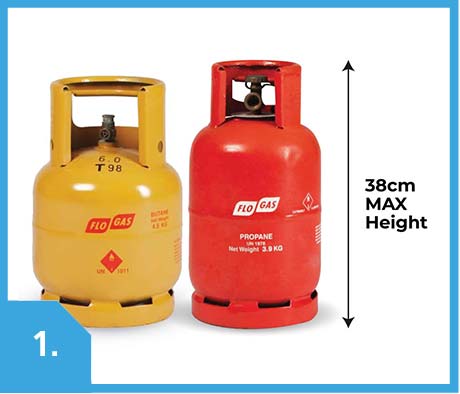

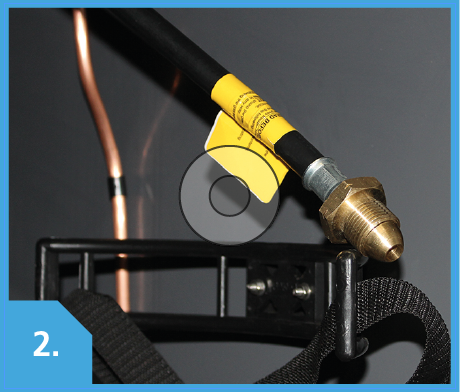

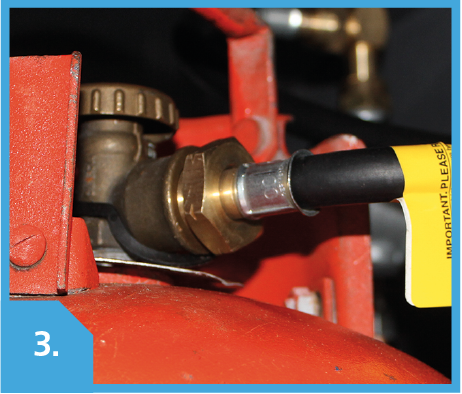

CHECK THE INSTRUCTIONS FOR CORRECT FITMENT AND SAFE USE WITH THE GAS CYLINDER MANUFACTURER/SUPPLIER.
ALWAYS ENSURE THAT THE GAS CYLINDER RETAINING STRAPS ARE FITTED WHENEVER A GAS CYLINDER IS INSTALLED IN THE FRONT LOCKER COMPARTMENT, EVEN WHEN THE OPUS® IS STATIONARY.
4. The gas tap/valve on the top of the gas bottle can now be opened.
5. Turn on the red gas tap (situated underneath the kitchen base unit) by turning 90° as detailed in the set-up section if you haven’t already done so.
6. Lift up the glass lid of the gas hob, turn on one of the burners (push in, turn and hold) and ignite by pressing the piezo button. Keep pressing the button until the gas has had time to fill up the system and the burner will ignite.
SAFETY FIRST! ALWAYS KEEP THE GLASS LID CLOSED WHEN THE GAS HOB IS NOT IN USE. ENSURE BURNERS ARE TURNED OFF WHEN NOT IN USE.
7. Ensure that the gas bottle valve is closed prior to packing up the OPUS® for transit or storage.
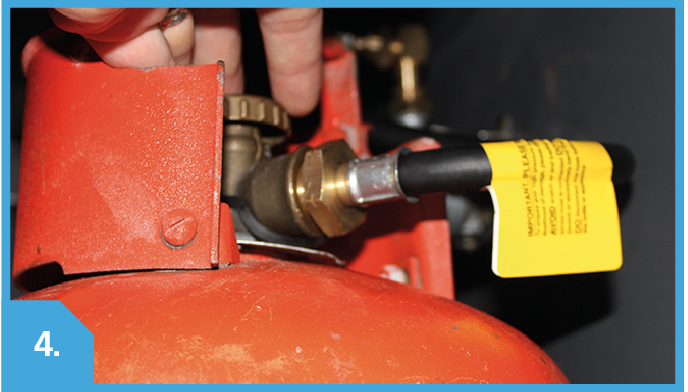

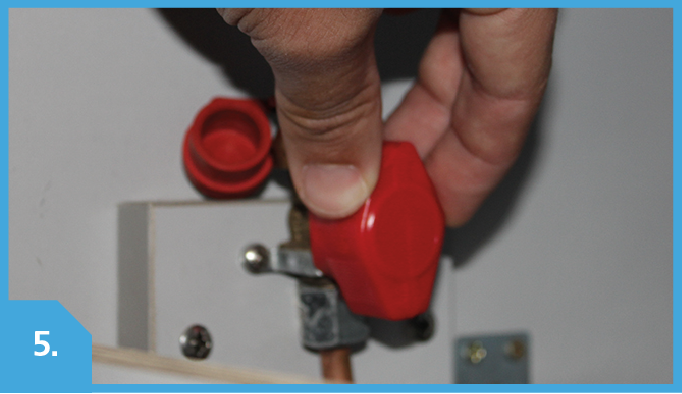

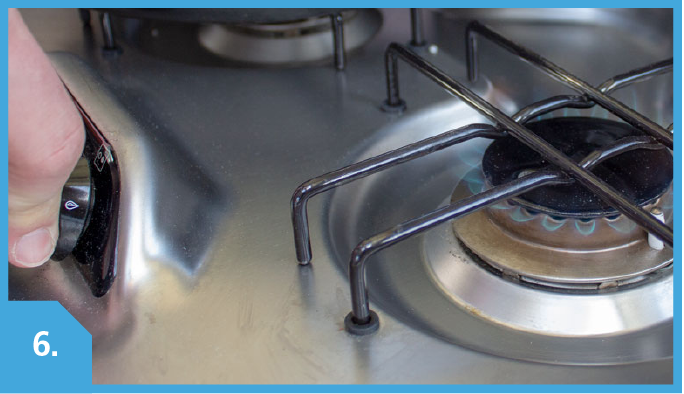

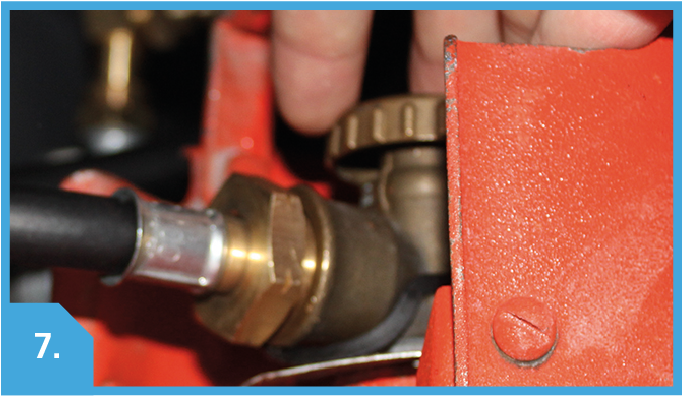

NEVER USE THE GAS HOB AS A SOURCE OF HEATING.
ALWAYS ENSURE THAT ONE OR MORE OF THE WINDOWS ARE OPENED TO ALLOW FOR ADEQUATE VENTILATION WHEN THE HOB IS IN USE.
THE GAS SYSTEM OF THE CAMPER IS DESIGNED FOR USE WITH THE GAS HOB ONLY; DO NOT USE ANY OTHER GAS APPLIANCE WITH IT.
OPUS® recommends using FLOGAS propane bottles under 38cm in height.


The agreement for the bottle is between yourself and FLOGAS. www.flogas.co.uk
1. To connect the OPUS® to a 240v mains power supply, unlock the battery compartment door and plug in a suitable electric hook up extension cable. There is a recess in the bottom left-hand corner of the battery compartment to enable the door to be closed and locked, even when the cable is connected.
2. Once connected to a camping site supply or your home’s supply (via a mains 3-pin plug to a round socket adaptor), your OPUS® leisure battery will be charging (provided the MCB’ in the consumer unit are on).
3. To operate the 12v electrical systems (you must have a leisure battery) they must be switched on at the power switch in the control panel situated just inside the door of your OPUS® on the right hand side.
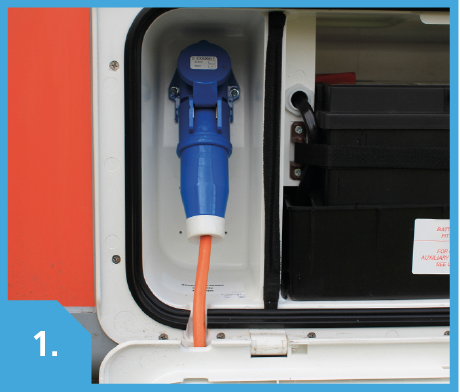

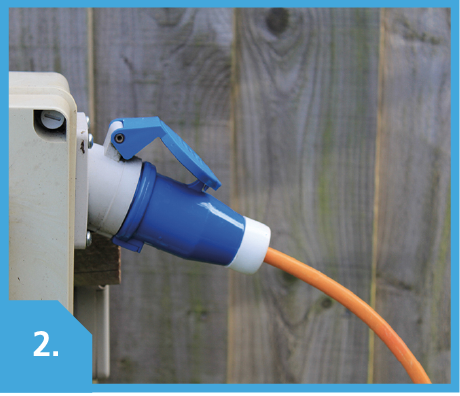

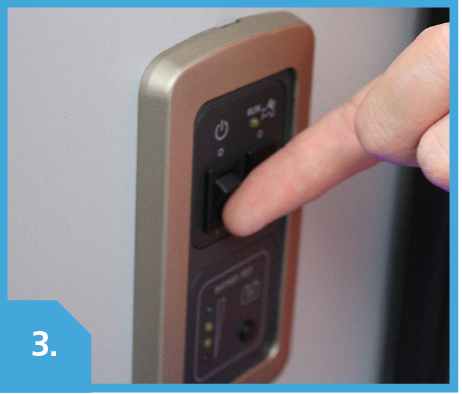

4. The internal 12v sockets (with the exception of the fridge 12v supply) the air pump and lighting will operate on 12v power from the leisure battery; heavy usage and power hungry appliances will deplete the battery’s charge. It is recommended to have the mains hook-up cable connected to a suitable supply if available, even if appliances are run on 12v only.
BATTERY USER GUIDANCE – BATTERY MANUFACTURERS STRONGLY ADVISE THAT A BATTERY BE RECHARGED AS SOON AS ITS CAPACITY FALLS BELOW 50% OF ITS FULLY CHARGED STATE. POWER SHOULD NOT BE DRAWN FROM A LEISURE BATTERY WHEN IT DROPS TO A COMPLETELY DISCHARGED STATE – 12V OR LESS. ALLOWING THIS TO HAPPEN MAKES IT VIRTUALLY IMPOSSIBLE TO FULLY CHARGE IT AGAIN.
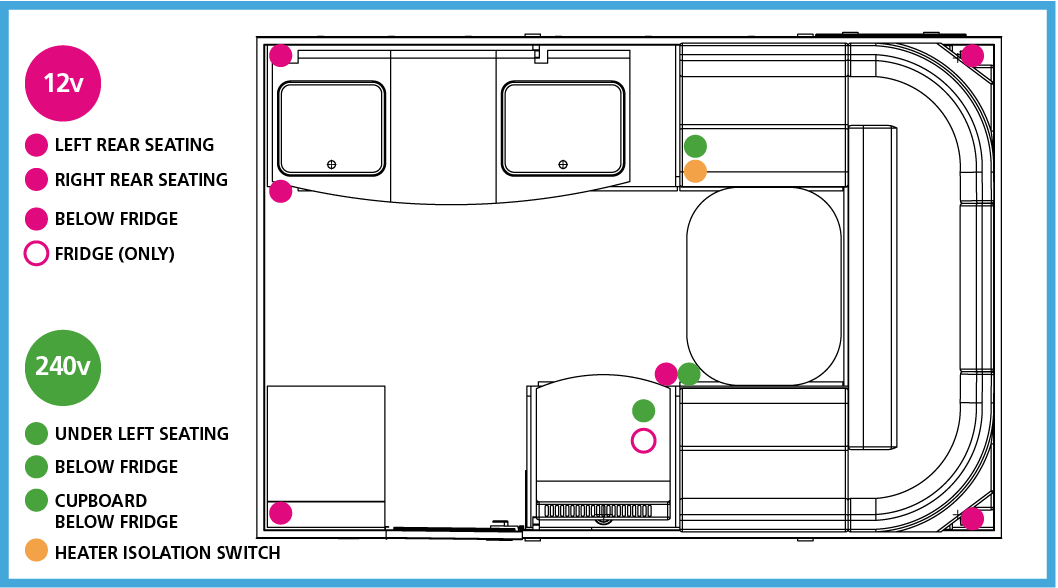

LOCATION OF 12v and 240v SOCKETS
WHETHER THE OPUS® LEISURE BATTERY HAS BEEN DEPLETED OR JUST USED FOR A SHORT PERIOD OF TIME (OR UNUSED FOR AN EXTENDED PERIOD IN STORAGE) IT MUST BE MAINTAINED IN A TOPPED-UP STATE EITHER VIA THE INTERNAL CHARGER (VIA MAINS HOOK UP) OR AN INDEPENDENT CHARGER (IF REMOVED FROM THE OPUS®). NOTE CHARGING TIMES MAY VARY, BUT IT MAY TAKE UP TO 48 HOURS TO FULLY CHARGE. LEAVING A BATTERY IN A PARTLY DISCHARGED STATE FOR A PERIOD OF WEEKS WILL PERMANENTLY REDUCE ITS CAPACITY TO HOLD CHARGE.
5. The control panel also has a battery colt-meter that will provide an indication of the remaining charge of the leisure battery. A full battery will be indicated by the top yellow LED (3rd light from the bottom); the green LED (top light) will only be lit whilst the battery is being charged i.e when connected to the mains hook-up.
6. There are four standard automotive blade fuses on the panel located underneath the fridge base unit which protect the circuitry of the 12v appliances in the Camper. If a fuse has blown it must only be replaced with one of the same amp rating. The system will also need to be checked by a qualified technician at the earliest opportunity to determine the cause of the blown fuse, as this maybe an indication of a circuit/component fault.
The fuses are allocated as follows:
A. Water pump (5A)
B. Spare (5A)
C. 12v sockets + LED Lighting (15A)
D. Inflation Pump (20A)
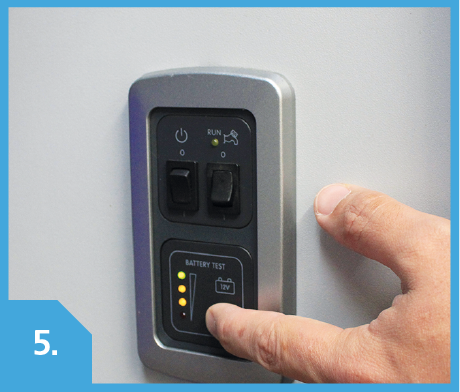

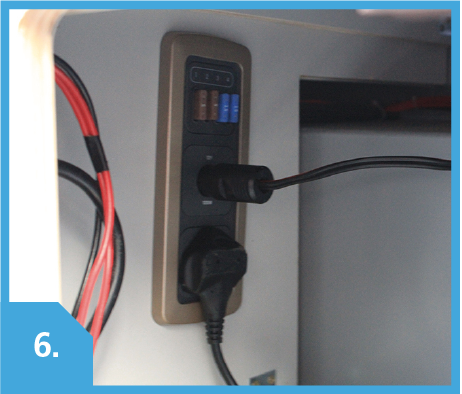

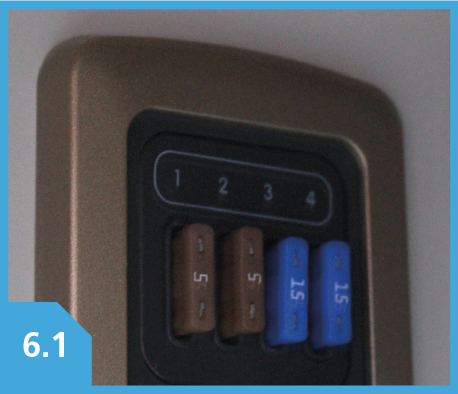

TAKE EXTRA CARE WHEN USING THE SOCKETS THAT ANY CABLE DOES NOT CAUSE A HAZARD, PARTICULARLY IN THE CASE OF SOCKETS NEXT TO THE HEATER. IT IS IMPORTANT THAT ANY APPLIANCE/ACCESSORY PLUGGED INTO THESE SOCKETS IS DISCONNECTED PRIOR TO USING THE HEATER.
7. The plinth heather is only for use when the OPUS® is connected to a mains electric hook-up (240v in UK). The front panel has an on/off switch and also a switch for setting half or full power (1kW/2kW). There is a 10amp fused spur with a separate on/off switch located within the seat unit to the right of the heater. The heater must be isolated by using the fused spur switch; this disables the on/off switch on the front panel of the heater.
SAFETY WARNING: DO NOT COVER THE FRONT OF THE HEATER.
DO NOT LEAVE ANYTHING IN FRONT OF OR NEAR THE HEATER WHILST IN OPERATION.
NEVER LEAVE THE OPUS® UNATTENDED WHILST THE HEATHER IS IN OPERATION.
NEVER LEAVE THE HEATER ON WHEN SLEEPING.
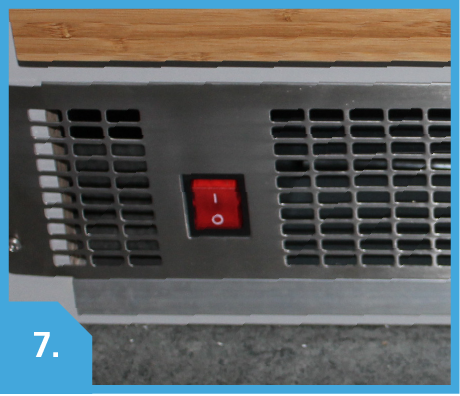

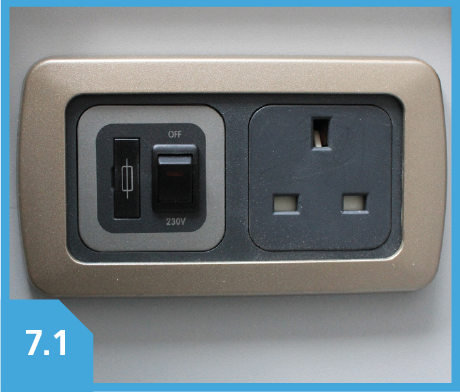

PLEASE ENSURE BEFORE PACKING DOWN THE OPUS® THAT THE ISOLATION SWITCH (7.1) IS TURNED ‘OFF’ FOR SAFETY REASONS. THIS IS ESSENTIAL IF CHARGING THE LEISURE BATTERY IN STORAGE.
8. Within the off-side seat unit is the battery compartment box, the battery transformer and the mains electric consumer unit.
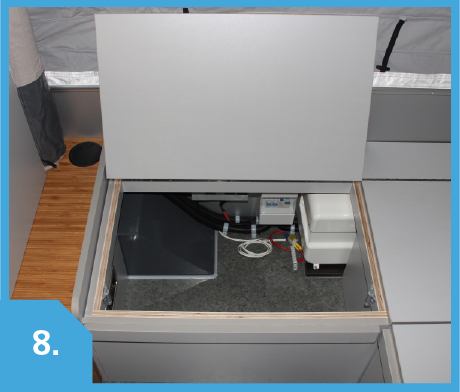

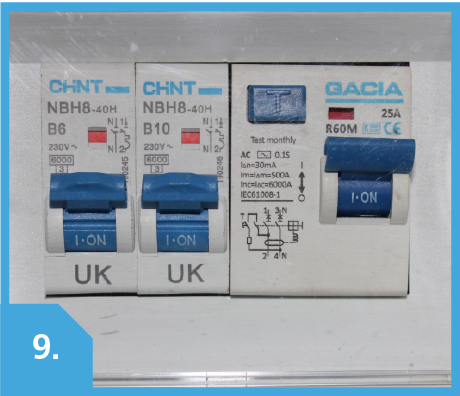

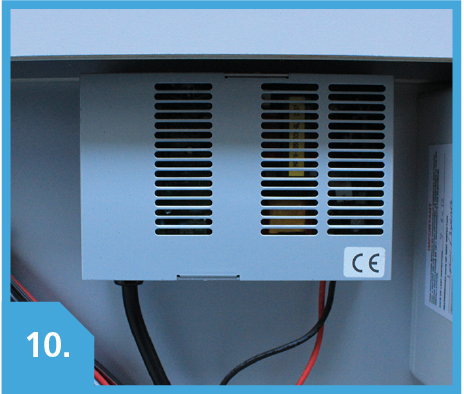

9. The consumer unit has circuit breakers that operate in the same way as your home’s domestic power supply and trip out in the event of some form of circuit/appliance overload. These are governed by a main RCD switch. The mains electric input can be switched off using the RCD switch. If one of the breakers is tripped, it can be reset by flicking the switch up. However, if the breaker won’t reset there is a problem with one of the circuits or appliances attached to it and this must be attended to by a qualified technician at the earliest opportunity.
10. The battery transformer is fully automatic and will recharge the leisure battery if the OPUS® is connected to an electric hook-up provided the MCB’ are on and in transit if the tow vehicle has the 13-pin or twin 7-pin sockets.
DO NOT OVERLOAD THE 240V 3PIN SOCKET OUTLETS OF YOUR OPUS®. YOU CANNOT EXCEED 10A LOADING AT ANY ONE TIME WITHOUT ACTIVATING THE CIRCUIT BREAKERS (I.E YOUR HEATER OPERATES AT 10A)
IMPORTANT! IF YOU HAVE TO PACK DOWN THE CAMPER WET OR DAMP TO TRAVEL ENSURE IT IS OPENED WITHIN 24 HOURS AND LEFT TO DRY FULLY.
Essentially the pack down procedure is a direct reverse of setting up.
Please note the following points:
1. The seat bases remain in their respective positions.
2. Remove the table & table support leg (if fitted).
3. The two side seat backs can be stored in the central rear seat storage unit if required (the back full length cushion may need to be moved/lifted if necessary).
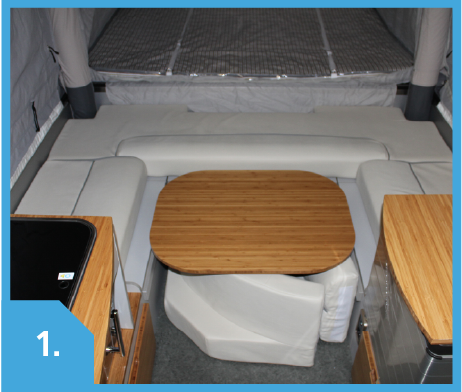

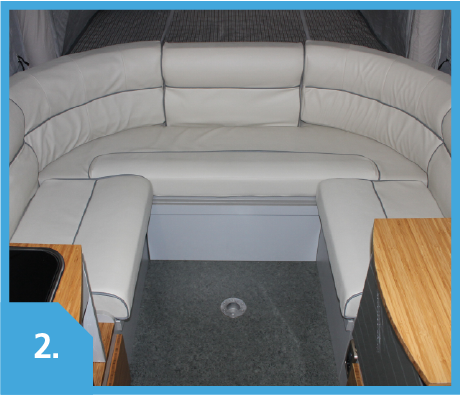

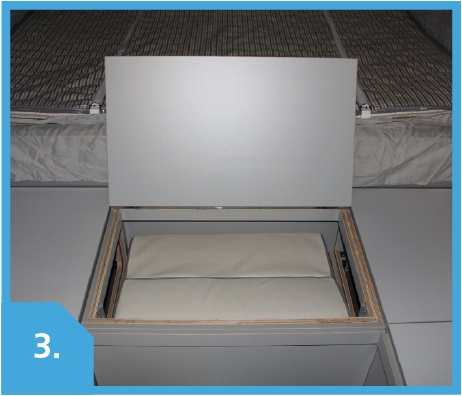

THE OPUS INTERIOR NOW CONTAINS A MIX OF TECHNICAL FABRICS OF CONTRASTING COLOUR. SOME OF THE DARKER FABRICS ARE DYED AND CONSEQUENTLY THIS COULD TRANSFER ON TO LIGHTER FABRIC. THE LIKELIHOOD OF THIS IS INCREASED WHEN THE OPUS IS PACKED DOWN, AND MATERIALS ARE HARD PRESSED AGAINST ONE ANOTHER FOR LONG PERIODS AT DIFFERING TEMPERATURES.
4. The arrangements of the cushions and contents of the trailer may be arranged to accommodate your personal items and payload; ensure that the trailer is properly loaded and balanced as described in the sensible loading paragraph and image of this user manual.
5. Ensure that all 4 roof window blinds are fully closed and that all side windows within the OPUS have both Perspex and solid window blinds fully closed to ensure no damage to window elements.
A USEFUL REFERENCE FOR PACK-DOWN IS THAT NOTHING STORED WITHIN THE OPUS® FOR TRANSIT CAN BE TALLER THAN THE SEAT BASES; OTHERWISE IT WILL BE DIFFICULT TO CLOSE THE LIDS AND MAY CAUSE DAMAGE TO THE IF THEY BECOME OBSTRUCTED.
6. Ensure the internal water system and components have been packed away as detailed in the Water System Section.
7. Turn off the gas tap and disconnect the gas hose of the hob unit by pushing down the brass neck of the gas tap. Pull the hose from under the kitchen base, back through the aperture in the unit and store in the p-clip attached to the inside of the gas hob unit.
8. SWITCH OFF THE HEATER ISOLATION SWITCH. THIS RESIDES IN THE CUPBOARD AND IS NOT THE RED SWITCH ON THE HEATER ITSELF.
9. If you have a fridge, you will need to place it on the floor of the Camper for transit but you can leave it plugged into its dedicated 12v socket (located in the unit below where the fridge is housed) so that its contents can be kept cool during transit if a 13-pin or twin 7-pin electrics are used on the tow vehicle.
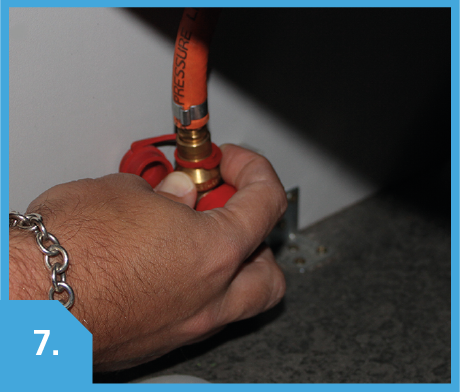

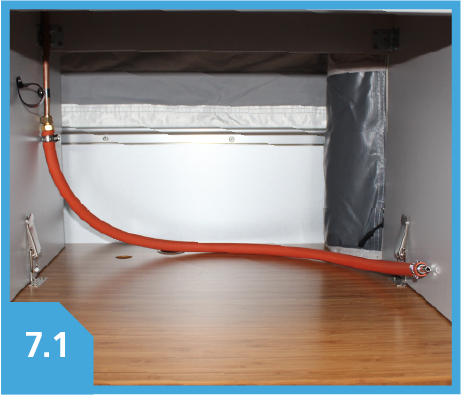

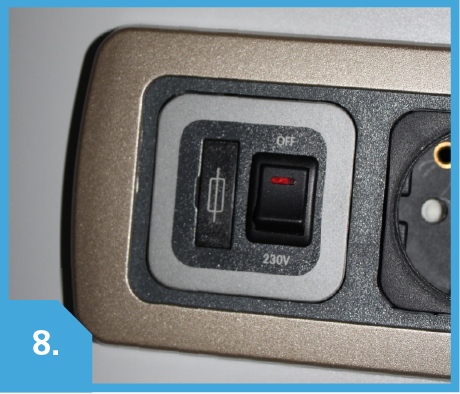

10. Switch off the gas valve on the gas bottle(s).
11. Disconnect the electric hook-up cable (if fitted).
12. Secure both mattresses with the retaining straps. Bedding can be left in the bed areas but must also be secured under the retaining straps.
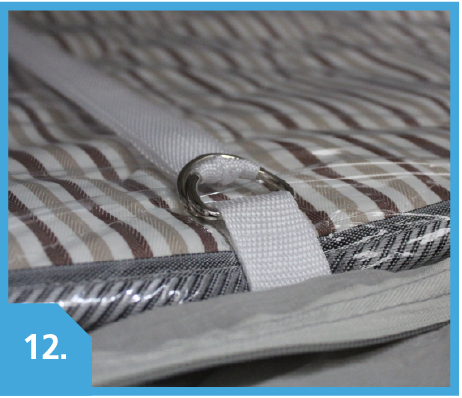

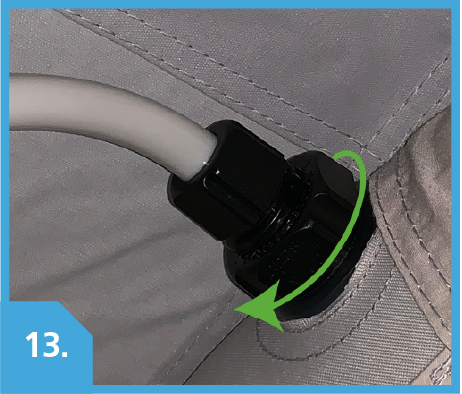

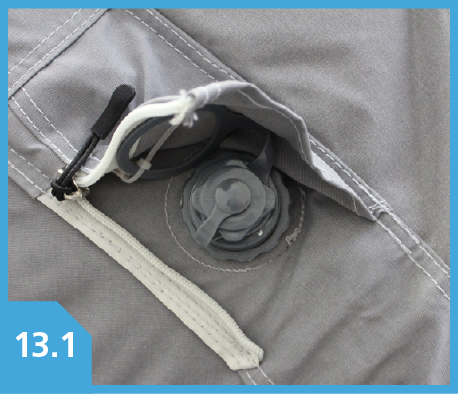

PLEASE ENSURE YOUR AIR TENT IS DRY BEFORE TAKING DOWN. IF IT IS NECESSARY TO PACK AWAY YOUR TENT WHILE IT IS WET, PLEASE DRY IT AS SOON AS POSSIBLE TO AVOID DAMAGE TO THE FABRIC AND COMPONENTS.
13. Open all internal AIR valves via larger hex nut. Then open all external AIR valves found in the external valve pockets. There are 5 external valves all located on the rear of the AIR OPUS®. As the canvas deflates carefully fold the canvas into the trailer. Ensure all canvas is housed inside the trailer body.
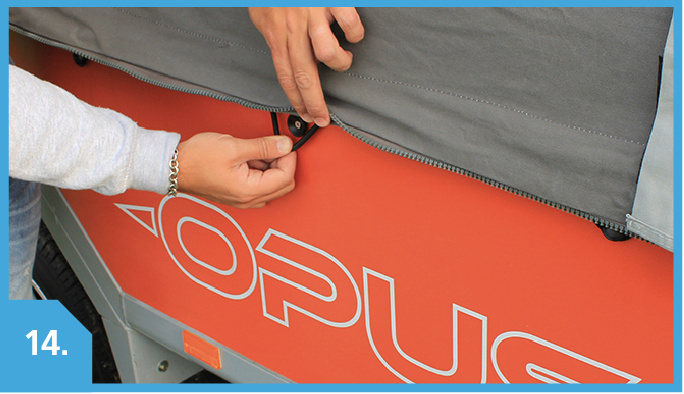

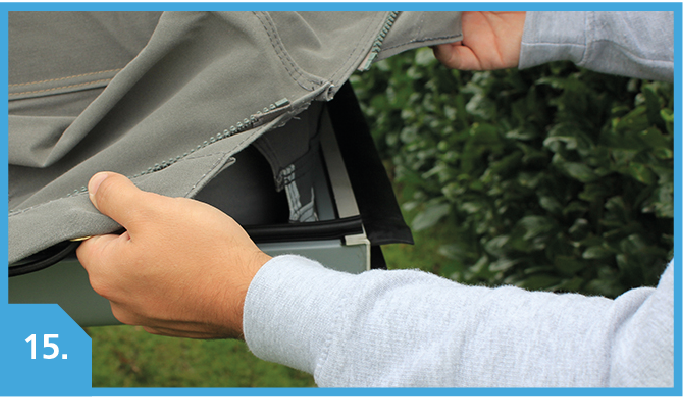

14. Ensure that the canvas is released from all the elastic bungee cleats on the exterior before closing the lids.
15. Lift the canvas off each corner of the bed trays on the exterior before folding.
16. Remove the four bed support legs. Insert the legs into the steel sub frame of the Camper with the retained pull pin end towards the exterior of the Camper.
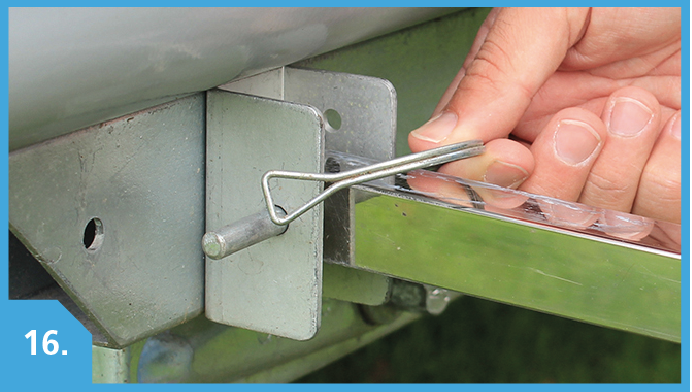

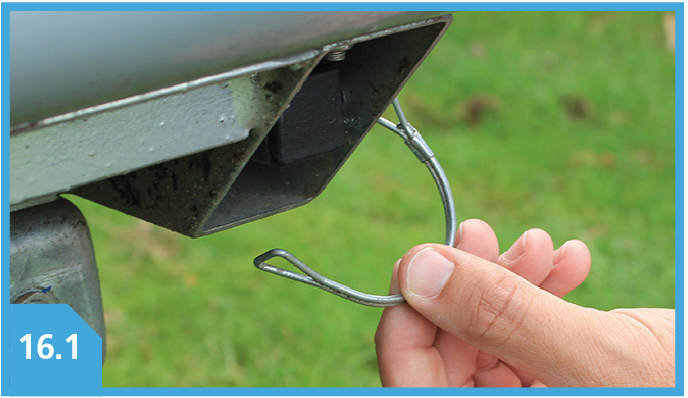

Use the D-pin and insert through the apertures on the steel frame and through the pin apertures on the leg as well as through the retaining ring of the retained pin secure the leg onto the Camper by hooking the D-wire over the pin.
17. Close the rear lid of the Camper first. Tuck in all excess (protruding) canvas as you go.
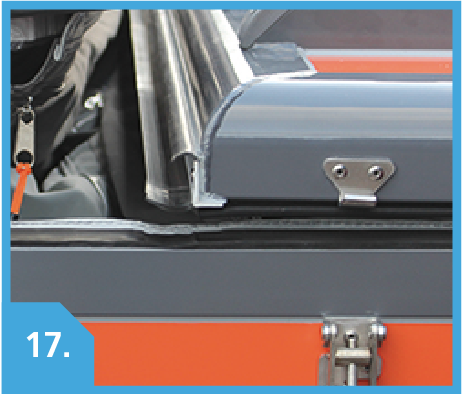

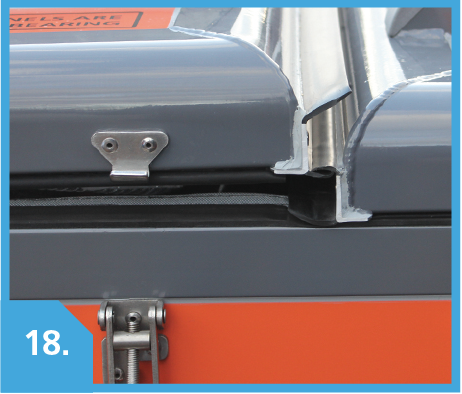

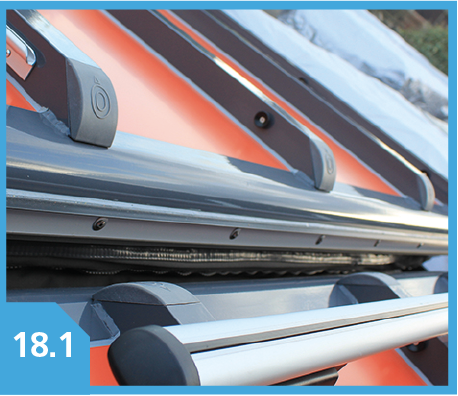

18. Close the front lid, again tuck in all excess canvas to ensure that no canvas is protruding from either side or across the middle where the two lids meet. Also ensure no canvas is snagged between the seal and lids behind the hinges.
IMPORTANT! IT IS ESSENTIAL THAT NO TENT MATERIAL IS VISIBLE WHEN THE LIDS ARE SECURED/CLOSED, AND THAT NO MATERIAL IS TOUCHING THE SEALS AROUND ALL SIDES OF THE OPUS® INCLUDING BEHIND THE HINGES.
19. Secure both lids by hooking the loop of the over-centre clamps onto the hooks on the lids and pulling down the lever.
DO NOT ADJUST THE LENGTH OF THE LOOP AS THIS COULD AFFECT THE ABILITY TO PREVENT INGRESS
20. Secure the water and waste containers (if applicable) to the trailer on their carriers located either side of the gas locker at the front of the Camper using the straps provided.
21. Ensure all four corner steady legs are fully raised prior to transit.
TIP: MAKE SURE THE CORNER STEADY WINDER (OR DRILL/DRILL DRIVER) IS EASILY ACCESSIBLE TO AID THE NEXT SETUP.
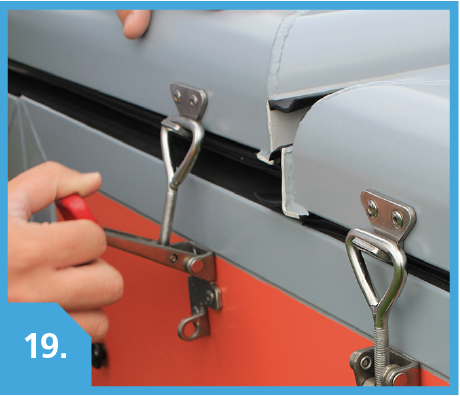

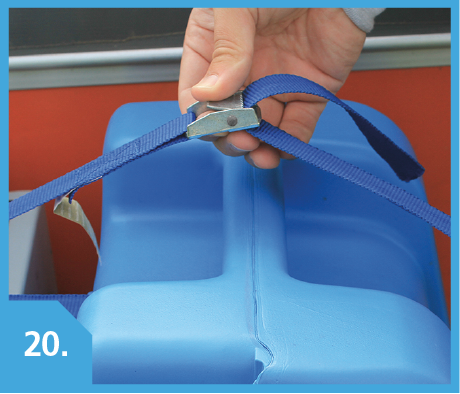

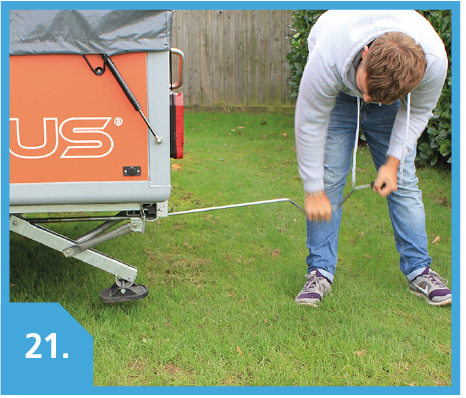

22. Fit the roof cover appropriate to your OPUS® setup.
23. Before you attempt to tow the OPUS® Camper, ensure that the Leisure Battery (if fitted) is sitting in the tray provided, that the strap is tightly fastened across the battery, and most importantly; that the battery box door is locked correctly. Tip: When locking/unlocking the battery compartment – apply pressure to the front of the door. The lock turns through 180 degrees from a fully unlocked to locked position.
FAILURE TO CHECK THIS COULD HAVE SERIOUS CONSEQUENCES IN TRANSIT.
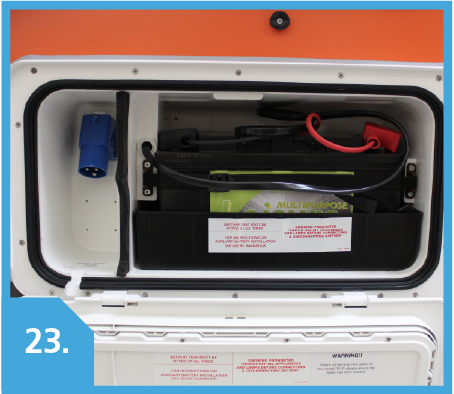

24. Before towing, please ensure that either the roof cover or load-carrying roof cover (if roof bars fitted) is fitted to prevent any prospect of water ingress. Always check the internal condition on return to ensure the OPUS® is dry and ready for storage. Return the full roof cover after your inspection.
Your OPUS® is now ready to go.
ADHERE TO THE CORRECT HITCHING AND UNHITCHING PROCEDURES
USEFUL GUIDES FOR SAFE AND LEGAL TOWING CAN BE FOUND ON LEADING CAMPING AND CARAVANNING ORGANISATION WEBSITES
PLEASE SEE HITCHING, UNHITCHING & SAFE TOWING SECTION
Optional extra – OFC195B-194
Try to choose a site that is relatively flat. Avoid sites where the land may flood or where water will run down. DO NOT pitch directly under trees. Pitching near a hedge or wall may provide shelter against wind. AVOID areas with heavy pollution and where crop spraying may be in progress.
1. Prepare Air OPUS Camper as shown in the set-up section.
2. Inflate the OPUS main tent to head height and stop the pump.
3. Remove Sun canopy from the carry/storage bag.
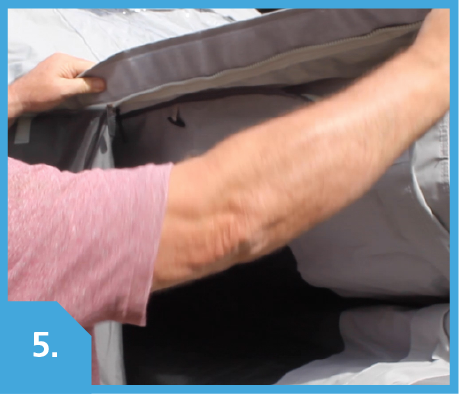

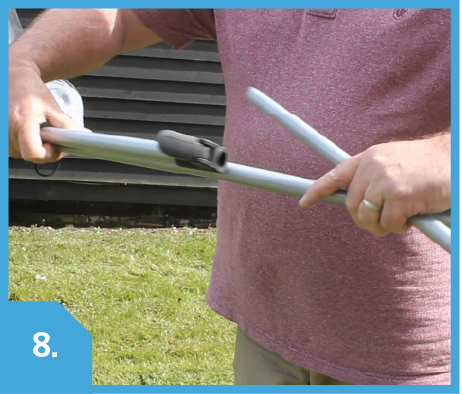

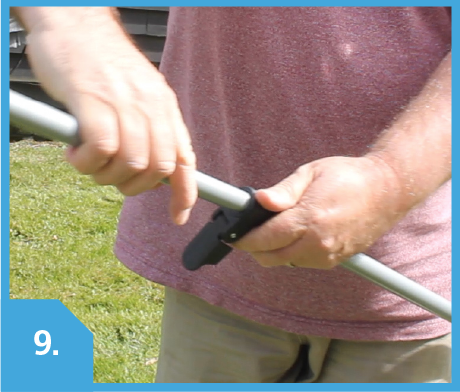

4. Ensure the ground is free of stones and other sharp objects. Unpack and spread the Sun canopy on the ground.
5. Slide the zip on the back of the Sun canopy onto the zip on the front of the AIR tent. The zip is located under the flap above the front door.
6. Ensure the AIR tent and Sun canopy are totally connected.
7. Inflate the OPUS main tent
8. Construct the shock corded pole by inserting the 3 sections into each other
9. Add the pole extension to the shock corded pole at the end with the adjustable clasp
10. Repeat for the remaining 2 poles
11. Unwrap the guy lines and locate the plastic adjuster
12. Tie an overhand loop knot to the opposite to the adjuster
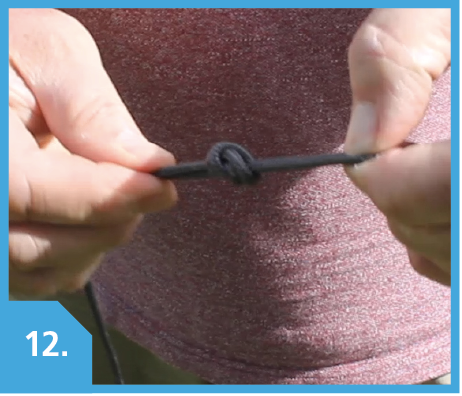

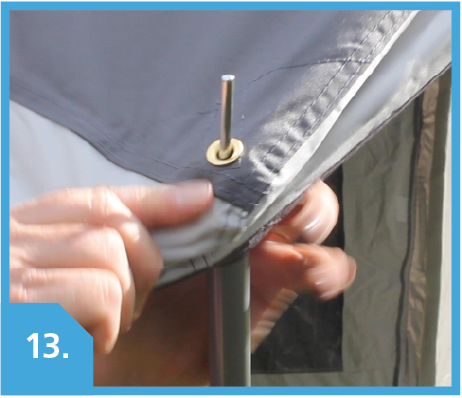

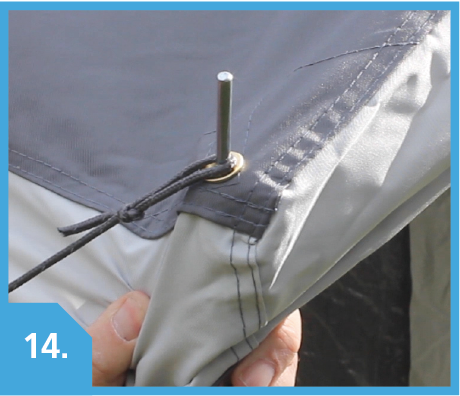

13. Take one of the poles and insert the pronged end into the central eyelet of the sun canopy
14. Whilst holding the pole place, take the guy line and place the looped end over poles prong
15. Adjust the pole to the height as required
16. Taking the guy line, tension the sun canopy and peg out
17. Repeat this process for the 2 poles either side of the centre (minor adjustments to all poles may be needed to ensure the sun canopy if fully tensioned.
18. Attached the canopy sides to the main tent using the velcro
19. Attach the ladder bands to the bottom of the canopy sides and peg out
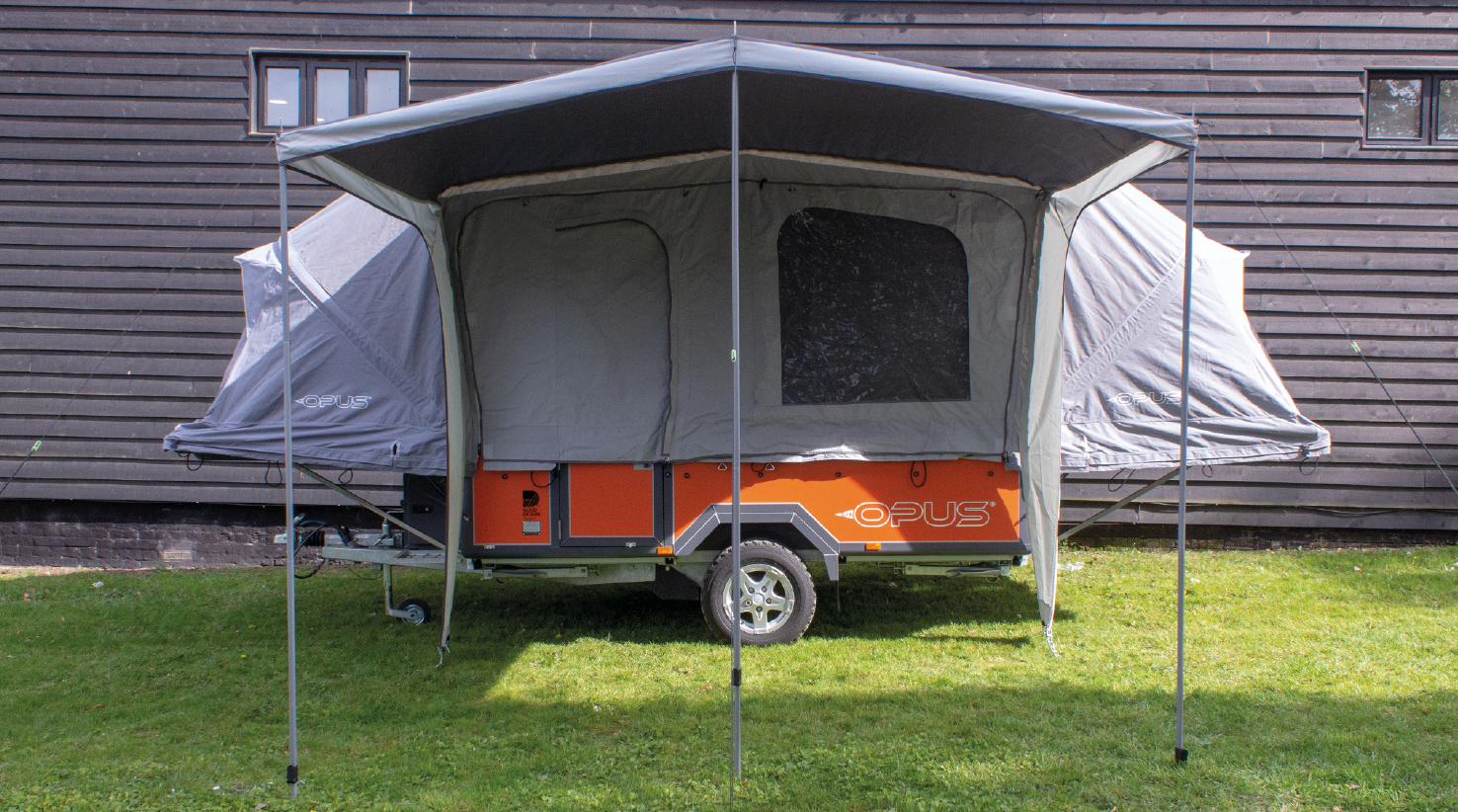

Optional extra – OFC195B-102
Try to choose a site that is relatively flat. Avoid sites where the land may flood or where water will run down. DO NOT pitch directly under trees. Pitching near a hedge or wall may provide shelter against wind. AVOID areas with heavy pollution and where crop spraying may be in progress.
1. Prepare Air OPUS Camper as shown in the set-up section.
2. Inflate the OPUS main tent to head height and stop the pump.
3. Remove AIR Awning from the carry/storage bag.
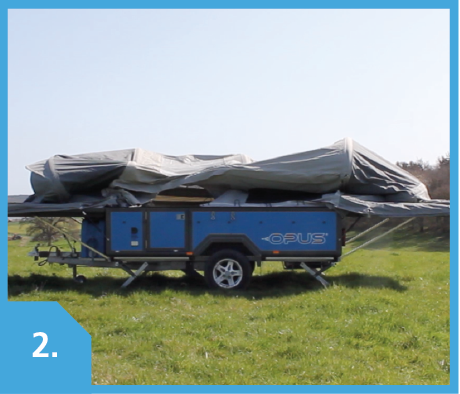

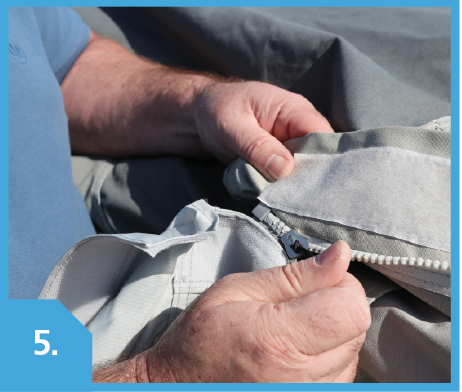

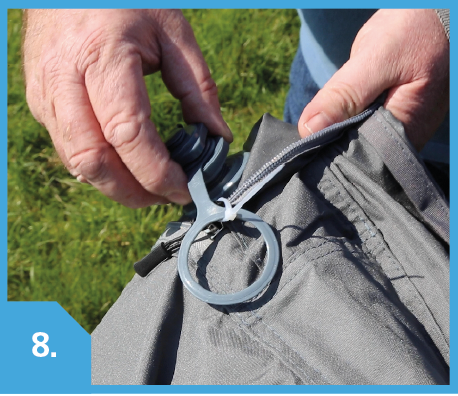

4. Ensure the ground is free of stones and other sharp objects. Unpack and spread the AIR awning on the ground.
5. Slide the zip on the back of the AIR awning onto the zip on the front of the AIR tent. The zip is located under the flap above the front door.
5. Temporarily peg the 4 corners of the flysheet in line with your AIR OPUS® tent. You may need to re-peg these at a later stage.
6. Ensure the AIR tent and AIR awning are totally connected.
7. Inflate the OPUS main tent
8. Ensure all external AIR valves are closed to allow for inflation and ensure all internal valves are open.
9. Locate the awning extension hose and connect to the existing hose inside the OPUS.
10. Locate the white inflator valve on the awning and insert the awning extension hose into the inflator valve and press the button to activate the pump.
11. The AIR awning will inflate, ensure that no air beams are twisted during inflation. The pump will automatically switch off when the pressure has reached 7psi.
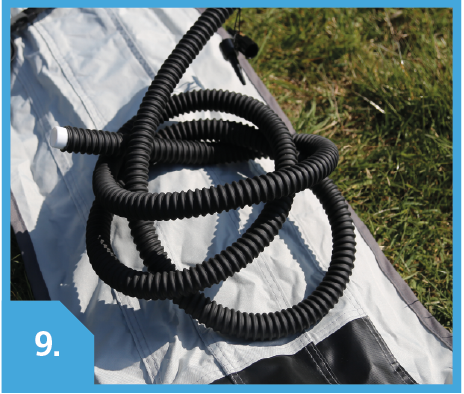

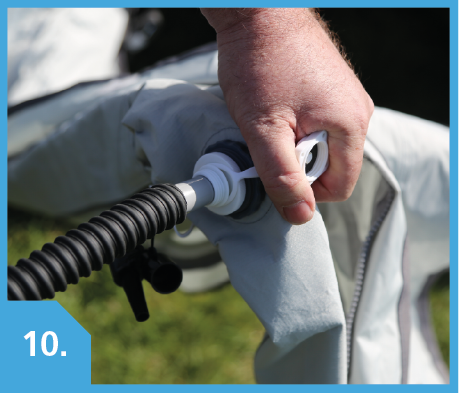

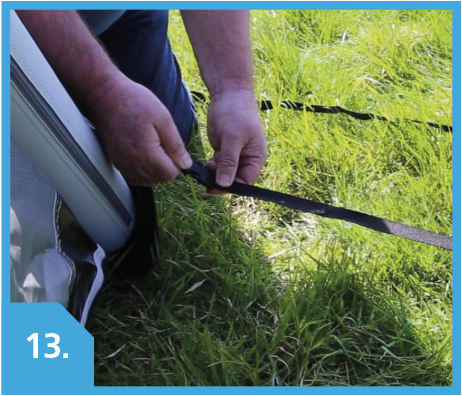

12. Close all internal valves. We recommend you keep all valves closed whilst product is in use.
13. Clip in the two guide straps from the front left and right hand side air beams into rear beams.
14. Peg out the guide straps creating a 90 degree angle between the front and rear beams.
15. Zip in the 2 x side panels and the 2 x front doors.
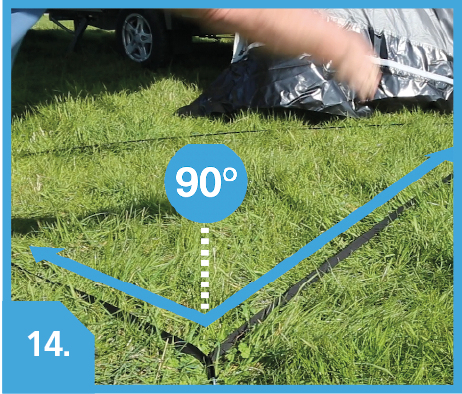

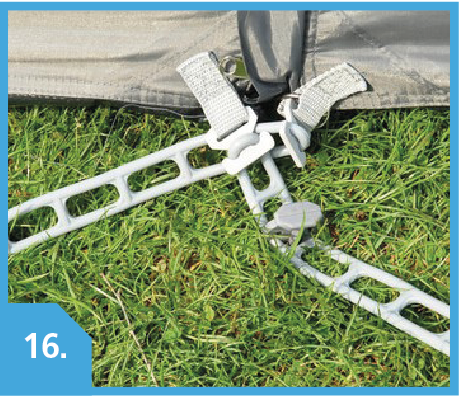

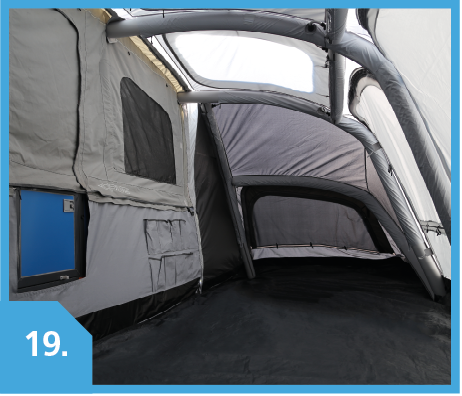

16. Peg out the storm straps and guy lines. Start with rear corners then peg the front corners, ensuring that there is no slack material between the four corners. Peg the remaining pegging points, cross pegging the doorways and entrances. Adjust the guy lines and storm straps as necessary.
17. Locate the front skirt and zip into the front of the OPUS main tent and peg out.
18. Attach the velcro sections of awning to the side of the main tent and front skirt,
19. Your AIR awning includes a groundsheet which may be used by carefully matching its Velcro to the relevant Velcro on the awning flysheet and the AIR tent skirt.
20. If required attach inner tents to internal fixings at both ends of the awning. The fixings are colour coded.
21. There are zipped PVC pockets for the use of LED light strips (optional extra) within some of your AIR awning roof beams.
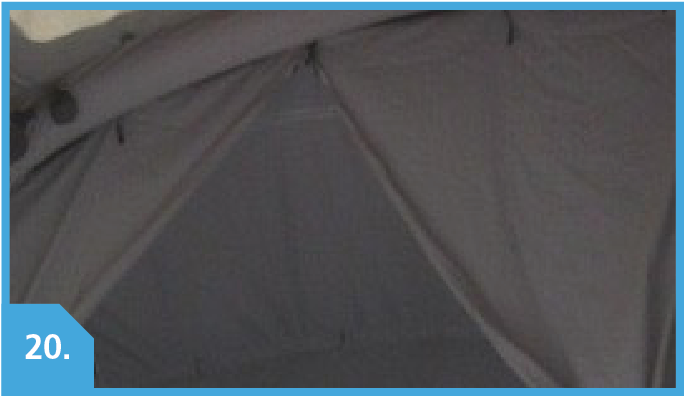

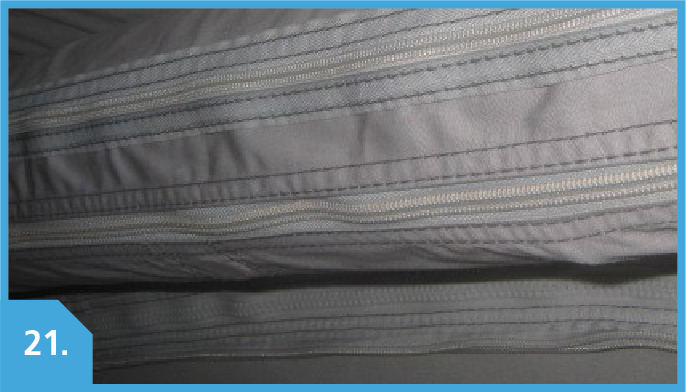

PLEASE ENSURE BOTH AIR TENT AND AIR AWNING ARE COMPLETELY DRY BEFORE TAKING THEM DOWN AND PACKING THE UNIT AWAY.
1. Open all internal valves.
2. Open all external valves.
3. Undo the Velcro patches attaching the AIR tent and the AIR awning. Then unzip the AIR awning from the front zip located on the AIR tent.
4. Carefully fold the AIR awning canvas and place it back into carry/storage bags.
IMPORTANT! PLEASE READ THE SECTIONS WITH INFORMATION ON WEATHERING, TECHNOLOGY, INFLATION, DEFLATION, SAFETY, ALTERATIONS AND WARRANTY. ALL TEXT APPLIES TO THE AIR AWNING AS WELL AS THE AIR OPUS® TENT.
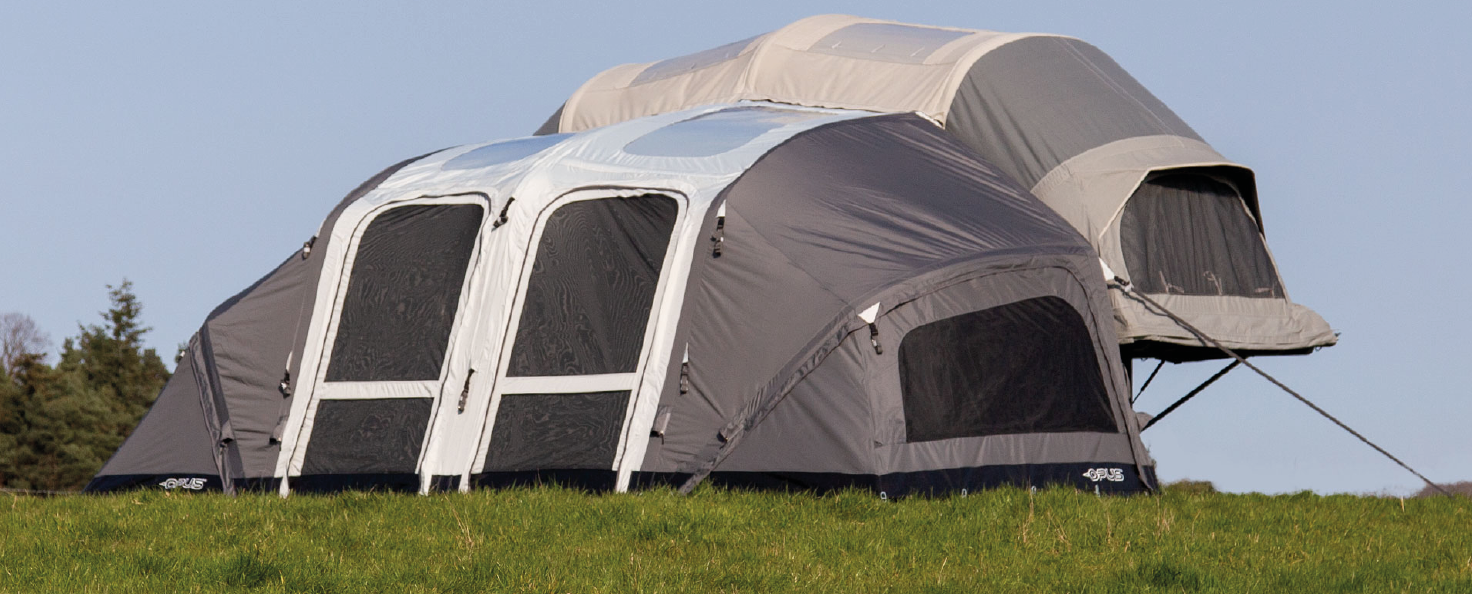

Optional extras – OFC195C-190 and OFC195C-191
1. Remove Air Windbreak from the carry/storage bag.
2. Ensure the ground is free of stones and other sharp objects. Unpack and spread the respective panels on the ground ensuring they are not twisted.
3. Locate and connect up your OPUS extension hose, attach this to the inflation point on the a windbreak panel. Alternatively, connect up the supplied hand pump for inflation.
4. Proceed to inflate/pump up each windbreak panel independently to 7PSI, ensuring not to over inflate.
5. Once inflated, be sure to screw on the caps of each inflation point, being careful to avoid over-tightening.
DO NOT ATTEMPT TO TIGHTEN VALVES USING THE SUPPLIED VALVE WRENCH. THIS WRENCH IS INCLUDED TO AID IN LOOSENING VALVES ONLY.
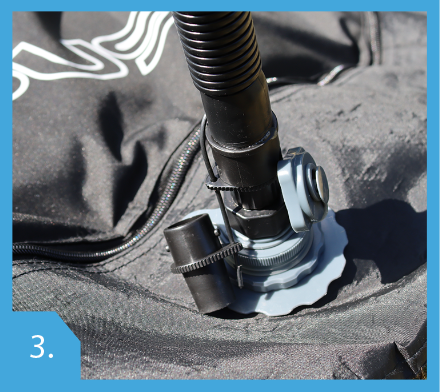

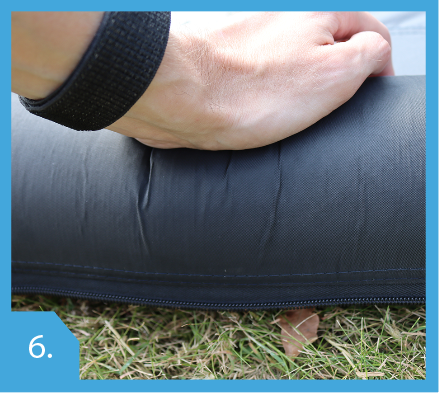

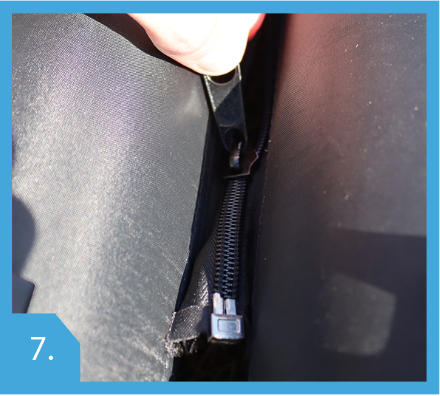

6. At this stage, check the shape of each panel, if when stood up the panel bends slightly, correct by laying flat and applying a small amount of pressure in the relevant areas to straighten.
7. With the panels inflated, arrange them in the desired order and zip the relevant ends to one another.
8. Once zipped together the panels can be stood up and arranged as desired.
9. Once located correctly, proceed to peg down each panel via the fabric loops at either bottom corner.
10. Where necessary, clip in guy straps and peg down to ensure stability of the panels, particularly in high winds.
11. Arrangements of panels can be manipulated, added to and relocated in any way desired. Additional large panels are available for purchase.
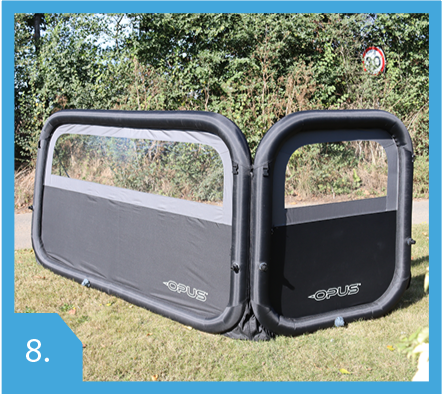

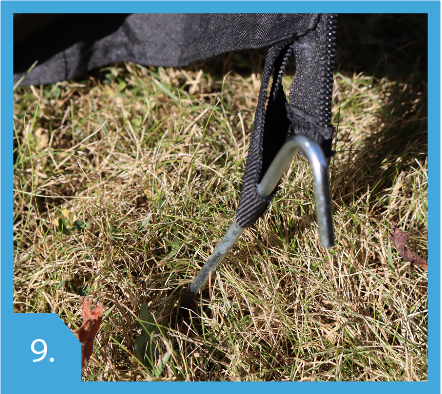

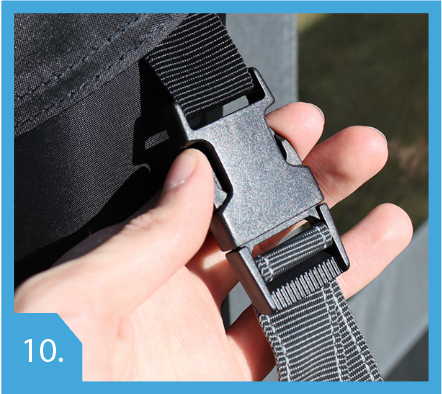

PLEASE ENSURE WINDBREAK PANELS ARE COMPLETELY DRY BEFORE TAKING THEM DOWN AND PACKING AWAY.
1. Remove all pegs and guy straps. Place these in the provided peg bag for safe keeping.
2. Lay panels flat down and open inflation/deflation valves, a valve wrench is provided for assistance in loosening where necessary. Allow all air to escape from the panels.
3. Unzip panels from one another.
4. Fold panels and place back in carry/storage bag.
Roof bars can be fitted to your OPUS® Camper to take advantage of the load carrying platform. Roof bars can be purchased directly from OPUS® Camper as an optional extra, along with bike and kayak carriers.
The roof bars used require clamp on feet which grip onto the rails fitted on the roof lid ribs.
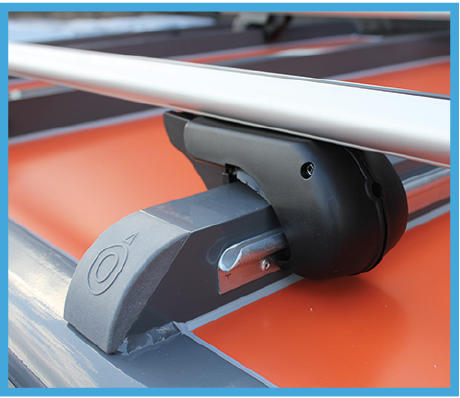

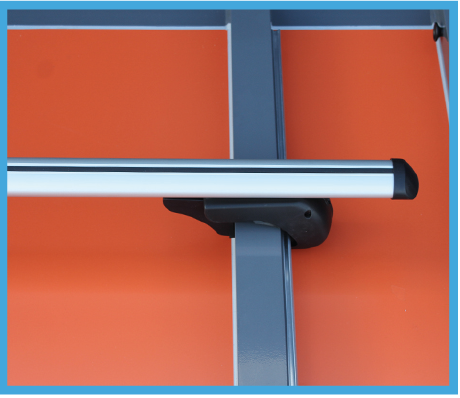

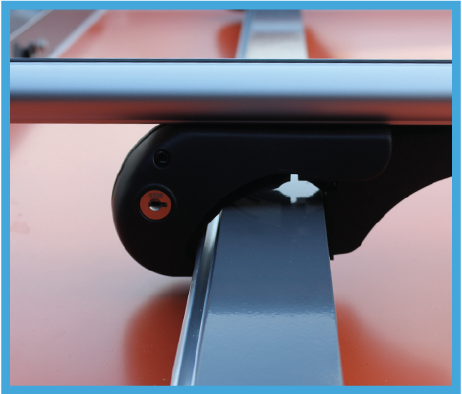

ROOF BAR FEET CLAMP OVER THE GRIP RAILS FITTED ON THE ROOF LID RIBS.
THE ROOF PANELS ON THE OPUS® ARE NOT WEIGHT-BEARING. DO NOT PLACE ANY ITEMS/WEIGHT ON THE ROOF PANELS AS THIS COULD CAUSE DAMAGE TO THE ROOF.


Check the sealants on the roof panels to ensure there has been no separation of the sealant to the panel or the frame of the Camper; this is important to prevent water ingress into the Camper and keep the roof water tight, to maintain this feature DO NOT stand on the panels of the OPUS®.
Up to 2 sets/pairs of roof bars may be fitted on the Camper (1 set on each roof lid) for the lids to carry loads independently. If required or preferred a pair may be fitted across both lids (1 piece of roof bar on each lid) to keep the load on the Camper more central. This may be needed to keep/maintain the proper loading of the Camper. If the roof bars are fitted across both lids be aware if bicycle carriers etc are fitted these will need to be removed before the OPUS® can be set up.
DO NOT OVER TIGHTEN ROOF BARS, BIKE CARRIERS OR ANY ACCESSORIES USED ON THE ROOF BARS TO AVOID DAMAGE.
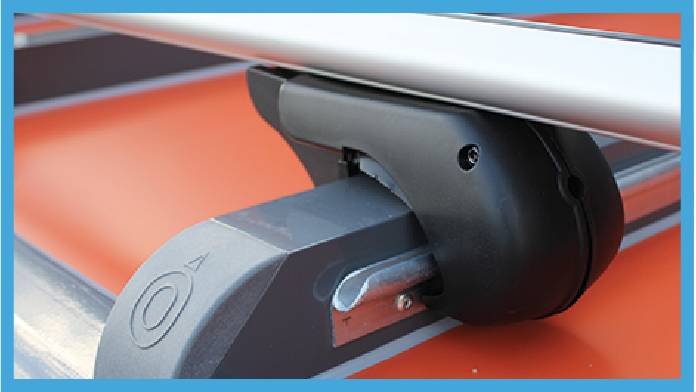



Each roof half (bed tray lid) should NEVER be subjected to a load more than 100kg – including the weight of the roof bars & fittings. It may be desirable to have the load(s) spread across both roof lids depending on the requirements – as shown in the left image above.
MOST ROOF BARS ARE NOT DESIGNED TO CARRY ANY WEIGHT ABOVE 75KG. THIS EFFECTIVELY BECOMES THE ‘LOAD CAPACITY CEILING’ FOR ANYTHING TO BE CARRIED ON ROOF BARS.
Loads on the roof must be loaded and secured appropriately; The MTPLM (1050kg) of the Camper MUST NEVER be exceeded, this includes the weight of the Camper and everything inside and on it.
Ensure the trailer has the proper weight and balance and the nose weight is between 50-75kg and within the capacity of the towing vehicle.
If a roof box is to be used, it may be desirable to have this on the ‘rear lid’ to negate the need of removing it for every setup (front lid would cause issue with gas locker box). Ensure the load is within the limits and does not upset the weight and balance of the Camper to avoid adverse handling effects.
Refer to the loading illustration in the Sensible Loading Section for distribution of loads.
The bicycle/kayak carriers can be used in the following configurations:
1 set of roof bars can hold:
2 sets of roof bars can hold:
IF TOWING WITH ROOF BARS FITTED, IT IS ESSENTIAL THAT THE LOAD CARRYING ROOF COVER IS EMPLOYED (IT CAN REMAIN IN SITU FOR THE LENGTH OF YOUR STAY, COURTESY OF A VELCRO CENTRE SEAM, ALLOWING THE LIDS TO OPEN). FAILURE TO ADOPT THIS COULD RESULT IN SIGNIFICANT WATER INGRESS IF THE SEAL HAS BEEN IMPINGED IN PACK DOWN (OR HAS BEEN COMPROMISED OR TORN AS A RESULT OF NORMAL USE). THE STANDARD ROOF COVER SHOULD BE REFITTED AFTER YOUR TRIP ONCE THE OPUS® HAS BEEN INSPECTED FOR STORAGE. ROOF BARS ACROSS BOTH LIDS (1 SET) ROOF BARS ON EITHER/BOTH LIDS (1/2 SETS)
THE OPUS® CAMPER MUST NOT BE STORED WITH A WET OR DAMP INTERIOR. IF PACK DOWN WAS UNAVOIDABLE IN WET OR DAMP CONDITIONS, THE CAMPER MUST BE OPENED UP WITHIN 24 HOURS AND FULLY LEFT TO DRY INTERNALLY AND EXTERNALLY (TENT) BEFORE BEING REPACKED (PLEASE ENSURE THIS INCLUDES UNDER THE WINDOWS) AND STORED UNDER THE ROOF COVER PROVIDED. PLEASE ALSO CONSIDER YOUR AWNING/CANOPY CANVAS.
IF THE OPUS® IS ERECTED FOR LONG PERIODS, PLEASE INSPECT REGULARLY FOR SIGNS OF WATER INGRESSION AND THE EFFECTS OF DAMP. REFER TO ‘CARING FOR YOUR CANVAS’ WITHIN THE USER MANUAL.
If you have an awning, it can also be stored in the trailer. To do this, ensure it is packed and stored properly. DO NOT store a wet/damp awning inside the Camper. If your payload/packing prohibits the awning pieces to be stored together, fold the individual pieces and store neatly in with the units maximising the use of space.
The front edge of the roof cover fits into an aluminium awning channel on the front panel of the Camper. This provides a secure fitment and MUST be attached in this manner when using the cover in transit.
THE ROOF COVER MUST BE USED WHENEVER YOU ARE NOT USING YOUR OPUS®. DO NOT USE THE LOAD CARRYING COVER FOR PROLONGED STORAGE NOR THE STORAGE COVER WHICH IS DUST PROOF ONLY.
IF YOUR OPUS® HAS BEEN STORED OR TRANSPORTED IN HEAVY WEATHER CONDITIONS WITHOUT THE ROOF COVER, IT NEEDS TO BE OPENED AND INSPECTED FOR WATER INGRESS AS SOON AS POSSIBLE. THIS IS TO ENSURE THE SEALS WERE CORRECTLY SEATED DURING THE PACK-DOWN AND THAT THEY HAVE NOT BEEN DAMAGED WITH TIME.
The larger storage cover (optional extra) is advised for an extended period of storage outdoors to keep your camper in pristine condition. Please note this is NOT WATERPROOF and must be used in conjunction with the full roof cover only.
It is strongly advised you clean off dirt and grime on the unit from travelling/terrain to keep your Camper in good condition and maximise its longevity.
If a leisure battery is fitted, please ensure it is charged immediately after use and for the required period. Do not leave the battery stored in a partly discharged state for longer than 48 hours. Charging the night before use is not a recommended principal.
Ensure the water and waste carriers are emptied after each use and contain no liquids if being stored.
Ensure that your Camper and accessories are fit for the road and you adhere to all local laws.
Check the wheels and tyres and ensure they are in good condition with the bolts correctly torqued. Check the tyre pressures before driving – 44 PSI / 3 BAR
Check the lights and fittings and ensure they are functioning correctly.
The chassis/running gear and the gas installation of your OPUS® Camper should be checked on an annual basis by a qualified service centre see – www.approvedworkshops.co.uk
The applicable manual is titled ‘BPW Maintenance and Operational Instructions – Light Trailer range 550kg-3500kg’
The technology used in your AIR OPUS® comprises of inflatable bladders, retained within a specially constructed grey tube which is held in position with a retaining sleeve within the tent/ flysheet. The zips on the grey sleeves are fastened with a fabric tie and should only be untied if you need to replace or repair a bladder. If you remove the ties fastening the zips, please ensure you secure the zips with the ties, in a closed position before re-inflation.
UNDER NO CIRCUMSTANCES REMOVE FASTENING TIES AND UNFASTEN ZIPS WHILE BLADDERS ARE INFLATED. FAILURE TO FOLLOW THIS INSTRUCTION WILL RESULT IN BLADDER FAILURE.
Please note that it may be necessary to monitor the AIR pressure in your AIR tubes from time to time, especially if the weather is fluctuating or the temperature is higher than average or colder than average.
Hot Weather – when the outside temperature rises it is probable that the pressure in the AIR tubes may increase and it will therefore be necessary to monitor the AIR tubes and release AIR using the external valves as required.
Cold Weather – a drop of pressure should not be considered a leak or puncture until further investigated. When the outside temperature drops it is probable that the pressure in the AIR tubes may decrease and it may therefore be necessary to monitor the AIR tubes and top up the AIR pressure as necessary.
A repair kit is enclosed with your AIR tent and includes an emergency repair patch for repair of small holes in your bladder.
Your AIR OPUS® Tent has been manufactured using a polyester/cotton fabric. Before a polyester/ cotton canvas is used for the first time, it is important that the tent is weathered. Inflate the AIR tent following the inflation instructions when rain is expected. When the cotton becomes wet for the first time, the weave of the cotton will close. There is no predetermined time for weathering so please do not be surprised/concerned if there is a small amount of leakage through the canvas and seams the first few times it rains.
Your AIR OPUS® Tent is made from the best available materials. On first examination, you may find some slight variances in colour, thick threads, pigment stains and changes due to the weather and the environment. These are all normal and will not affect the performance of the product and are not faults or errors.
When your AIR OPUS® is not inflated, the window material may pick up some impressions from zips, tape, seams etc. This is quite normal and some of these impressions will disappear over time but some may remain. This is not a fault.
Please ensure your AIR tent is only packed away when completely dry. A wet/damp canvas will develop mildew/mould very quickly and damage your canvas permanently.
The inside and outside of your AIR tent can be cleaned but only with fresh clean water and a damp cloth. UNDER NO CIRCUMSTANCES MUST DETERGENTS OR CHEMICAL CLEANERS be used as these will damage your tent.
You may also experience, depending on the weather and use, condensation. This should not be confused with leakage. To reduce the risks of condensation, please ensure your AIR OPUS® is adequately ventilated. Please note that under certain conditions, all tents will suffer from internal condensation depending on atmospheric conditions, the weather, the amount of moisture in the air/ground, evening and night time temperatures etc. Condensation can be quite severe causing a film of water on the inside of your tent (roof and sides) which may drip onto items in your AIR OPUS® and in severe conditions can leave puddles of water.
Zips should be treated with care, use two hands when closing and opening and do not step on them during set up or take down. Never force a zip. If a zip opening is tight it is more than likely due to the fact that your awning is not pitched correctly. Candle wax may be used to help a zip run more smoothly.
Please remember that your AIR tent is a temporary structure made from natural fibres. Please note that in fibre products used in outdoor applications, product life may be low because of attack from UV or acid rain. Discolouration of the fabric may be an early indication that your tent has been attacked. To limit damage by UV, where ever possible, please site your AIR OPUS® in a shaded area avoiding direct sunlight. Please be aware that continuous exposure is a more serious problem than intermittent exposure, since UV attack is dependent on the extent and degree of exposure. Fabrics can be weakened by prolonged exposure to sunlight and use for extended periods in strong sunlight will soon cause deterioration. UV degradation is not covered under the AIR OPUS® warranty. The warranty does not cover air tents used permanently or for display purposes.
Your AIR OPUS® tent has been manufactured using a special thread which expands and swells to close the holes made when stitching the product. The thread swells and expands when wet. It may take a few times for the holes to completely close.
The tent of your OPUS® is made from poly-cotton, a canvas type material. This has many benefits as it is breathable and results in a cooler interior in warm/hot weather and a warmer interior when in use in cooler weather conditions.
In order for the OPUS® to give you years of camping pleasure, the tent section needs to be cared for and MUST NOT be left wet/damp when packed away.
It is, of course unavoidable at times that you will have to pack down your OPUS® when the canvas is wet. It is very important that the OPUS® is opened up to dry off as soon as possible and should be done within 24 hours.
It is possible, due to the nature of the canvas that there may be a small amount of water ingress during the first few uses in wet weather; this is normal as the tent goes through ‘weathering’ or ‘conditioning’. If this persists, please notify us as soon as possible. Please refer to ‘Water Ingress’ under troubleshooting..
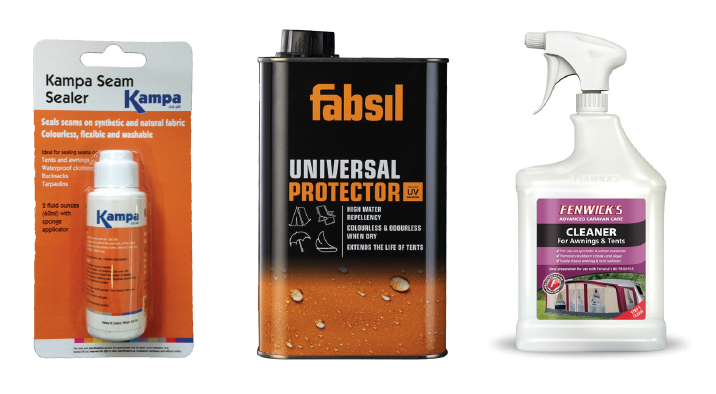

ENSURE THE COOKER/HOB UNIT HAS COOLED COMPLETELY BEFORE ATTEMPTING TO CLEAN.
Depending on the optional accessories fitted to your OPUS® you will find all relevant paperwork/manuals for these in the middle drawer of the kitchen area. Please read all of the relevant information within these user manuals to ensure correct usage.
The OPUS interior now contains a mix of technical fabrics of contrasting colour. Some of the darker fabrics are dyed and consequently this could transfer on to lighter fabric. The likelihood of this is increased when the OPUS is packed down, and materials are hard pressed against one another for long periods at differing temperatures.
To avoid the possibility of colour-transfer, our recommendations would be as follows:
Turn the dark cushions upside down, exposing the felt backing to the tent (there is no conflict between the colour-fast felt material and the tent material). This will help separate contact between the dark grey cushion tops and the tent, but you may wish to protect the cushion surfaces from the cupboard hinges by laying a suitable material between the two items.
Alternatively, A light-coloured, colour-fast material (such as a sofa throw or blanket) could be used to cover the cushion tops, before packing down.
Should colour transfer from dark to light material, we wish to reassure you that it will not affect the longevity or functionality of the material, but we appreciate the appearance is less than desirable and best avoided if possible.
Optional extra
If you have the Spare Wheel and Carrier fitted (optional extra) ensure it is fit for use.
It is secured by a 19mm hex bolt which can be loosened using a standard wheel wrench.
YOU MUST ENSURE THE SPARE WHEEL CARRIER BOLT IS FULLY TIGHTENED TO A TORQUE SETTING OF 55Nm. ENSURE THE SPARE WHEEL PRESSURE IS CHECKED REGULARLY. THE CORRECT PRESSURE IS 44 PSI or 3 BAR.
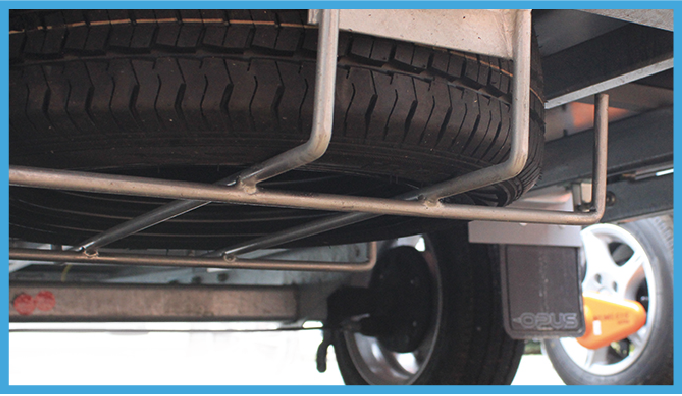

Condensation needs to be considered in both the OPUS Camper and Full Awning (optional extra).
Condensation is caused by warm, moist air coming into contact with cold surfaces. Condensation can occur inside most tents and awnings, which may sometimes be misinterpreted as the fabric leaking.
There is always moisture in the air when you pitch a waterproof fabric above damp ground; however the situation is made worse by adding people who are breathing out warm water vapour. When the warm moist air inside comes into contact with the fabric of the OPUS Camper tent or the awning material, which is cooled by the outside air, condensation forms.
During rain more condensation can form due to lower outside temperature and drops can form and run down seams or fall on internal poles, giving the appearance of a leak.
There are a few main causes of condensation:
It is natural for the body to perspire (sweat) during the night; please ensure the Camper is WELL VENTILATED to avoid excessive condensation which could result in issues such as mould or damp if adequate care is not taken.
After a night’s sleep please INSPECT AND FLIP the mattress to ensure no condensation is present and the mattress is properly aired.
Suggestions below of tips & products that could help combat condensation.
Products:
Tips:
Ventilation is more important than is generally realised – your OPUS® Camper/ Full Awning has several windows/vents that can be opened to help increase air ventilation. An increase in ventilation will result in a decrease of condensation.
The chassis/running gear and the gas installation of your OPUS® Camper should be checked on an annual basis by a qualified service centre see – www.approvedworkshops.co.uk
If you are experiencing any problems with the running lights:
If the lights are blinking too fast or erratically or not turning on at all (this might be encountered if you change your towing vehicle):
Symptoms:
OPUS Lights flashing/OPUS lights flickering/OPUS lights not working at all
Troubleshooting:
Ensure that the 13pin connector on your vehicle is functioning correctly, this can be tested either at your local main dealer or by connecting another trailer if available to see if the issue persists. Plug-in Smart Load Relay may be required*
*The towing vehicle CAN Bus system continually sends pulses to the towing sockets to detect the presence of a trailer. This is fine with conventional bulb lighting, but depending on the sensitivity of the CAN BUS system of the towing vehicle it may not detect the modern LED lighting used on the OPUS. This is because LED bulbs draw very little current (which is why they are so efficient). This means that some vehicles cannot sense that the OPUS is connected. The solution is to simulate the current draw of conventional bulb lighting so the towing vehicle recognises the fact it is actually hitched up the OPUS.
The heater will only operate on 240v/mains power supply.
If the heater is not turning on, check the safety switch underneath the seat – below cushion 1. If the switch is on and the heater is still not functioning its fuse might be blown. The heater only needs to be turned on for a short time to warm up the inside of the Camper when required and should be switched off afterwards, the Camper’s insulating properties will maintain this temperate condition.
Never leave the heater on overnight, when sleeping, unattended or for a prolonged period of time.
Never obstruct the heater.
The fridge runs off ‘mains’ electrics; the dedicated fridge 12v socket is available for use (with compatible tow vehicle electrics) simply to keep the fridge ‘cool’ during transit.
The fridge should not be used on gas inside the Camper or in an enclosed space.
If any of the 12v sockets are not working, the fuse for the 12v appliances may have blown, check and replace if necessary.
If a LED light or polarity sensitive appliance is not working on the 12v sockets but is functional then the polarity of the affected socket will need to be reversed. Please contact us on 01473 601200 for advice.
If the mains sockets are not working check the circuit breaker underneath Seat 1 (Page 16) to see if the switch has been tripped, reset this if necessary.
If the circuit breaker was tripped by a fault/issue that has not been resolved (breaker will trip after reset) then this needs to be investigated further.
Extension sockets may be used on the 12v and 240v mains electric if required but must be of adequate rating for the required function/load to avoid an electric/fire hazard.
If an issue occurs on a socket or electric appliance using an extension then it may be overloaded.
AVOID daisy chains of extensions and check that the rating (total) of the appliances being used does not exceed the stated extension socket/Campers rating.
The battery is recharged in transit if compatible electrics are used. If this is not the case or the Camper is being stored for a prolonged period of time then an alternative charger should be used to the keep the battery in a working condition.
The 12v electrics may not function properly or at all if there is insufficient charge in the battery, the battery charge can be monitored by the meter located on the main electric panel by the door of the Camper. Please refer to Page 21 for more information.
Please note the green LED light on this panel is only shown when connected to a main supply, normally when the battery is being charged.
Please ensure you have not left the inlet house in the white master valve. This must be removed and the cap replaced. Please ensure all external valves are fully closed. If the deflation persists, please listen for air loss at the internal bladder valves.
It is recommended and advised within your instructions that when your AIR OPUS® tent and awning are in use that all internal valves are closed. If this is the case then your faulty AIR tube/bladder will already be isolated and the impact of the faulty bladder will be minimal. Please check this is the case. If not please close all internal valves.
The awning rail is the anchor for the tent canvas to attach to the Camper’s body; the awning beading should remain central on the awning rail.
If the tent gets caught or snagged on the awning rail, retrace the setup/pack down steps to guide the awning beading to prevent damage to the tent.
It is normal for the tent’s awning beading to be able to move within the rail unless movement is hindered; DO NOT over tension the tent and NEVER force the tent to move along the rail, inspect for the hindrance and rectify before moving the tent’s awning beading.
Small holes, rips and tears can be rectified using a suitable tent repair kit or sealer. Always keep a kit with you in case of emergencies.
Larger damages may require the services of a professional, if in doubt or require any assistance please contact us on 01473 601200 for advice.
AVOID putting strain on the wrap around velcro straps that retain the poles on the tent as this may damage the stitching on the tent and/or encourage water ingress through enlarged holes. If damage to the stitching occurs, this needs to be repaired as soon as possible. For small damage use a fabric repair/sewing kit, otherwise seek a professional service or contact us.
Once a damage has occurred or a repair have been done on the tent stitching, consider using a ‘seam sealer’ or an appropriate repair kit to seal any needle holes or stitching gaps and keep the tent waterproof.
The bungees of the tent are made of durable elastic and will last for a very long time if not overstretched or abused.
If damage occurs on the bungees then it can be replaced by using a suitable alternative; depending on the section damaged this may require stitching/sewing or a knot at the ends of the bungee to retain it in the tent.
Stubborn stains can be removed using specialist products such as Fenwicks cleaning for awnings and tents.
When using a new/unfamiliar product try it on a small inconspicuous area and only use when satisfied with the suitability and result of the product.
Depending on the location and extent of the stain, the Camper may need to be set up to clean the tent. The tent may need to be re-proofed after cleaning, see section on the following page.
Reproofing is required as part of the maintenance of the tent to help restore its water runoff properties after prolonged used and exposure. Frequency of reproofing will depend on the use of the Camper.
Reproofing may also need to be done if some cleaning products have been used on the tent.
Areas to be mindful of are where tent panels are connected together or experience stresses i.e. stitches and seams. Grangers Fabsil Waterproofer or a suitable alternative may be used for this purpose.
If water ingress/leaks occurs which are not as result of condensation or incorrect pack down procedure then determine the location(s) and possible causes for the leak.
It is possible that minor leaks are due to the fact that the canvas has not been subjected to a weathering process. We selectively use Cotton Canvas on the OPUS® due to the materials superior durability and breathability. This means, as with all natural Cotton Canvas tents, the OPUS has to go through a weathering process before all the cotton fibres in the weave will swell and nestle into each other. This may result in drops of water passing through the canvas on its first few uses in wet conditions. The good news is those last few drips will go and you will be left with a perfectly waterproof tent and one that will give you years of good service if it is looked after.
If the leak is a result of holes, rips or tears (visible) damage then repair/address as described in the Rip & Tears section. Otherwise contact us or a professional for advice.
If it is difficult to zip the awning to the tent or side skirts etc. examine the zip(s) for any damage or cause of obstructions. Never force the zip.
If the zips are different on the tent section to the awning section/side skirts then zip adapters may be required. Contact us on 01473 601200 for more information.
If the hob is not functioning correctly:
DO NOT leave the gas flowing or the gas hob on if the burner is not in use.
Ensure the gas bottle is connected properly every time the gas bottle is changed.
Follow the manufacturers procedure/recommendations for any issues pertaining to the gas hob itself.
If the water supply has been set up correctly then fresh water should flow out of the tap and waste water out of the external outlet respectively.
If water is not flowing out of the tap check the hoses and connections, next check the pump and switch and that the fresh water container has enough water and the pump is fully submerged.
The waste water hose of the sink unit should be connected to the provided aperture on the kitchen base unit, the outlet (on the exterior) of the Camper should also be opened to prevent blockage or back flow of water. The supplied convoluted hose should also be connected to the outlet and into a suitable container or drain.
The pump should be submerged in a suitable container filled with water. NEVER run the pump dry.
The pump must be connected to the external socket, for it to function properly and supply water to the sinks tap.
The pump switch is located on the control panel by the door of the Camper and must be turned on for it to work. After initial turn on of the pump it may operate for a short while, this is normal and simply ‘primes’ the pump to readily supply water on demand.
Depending on location and flow of the water, if the flow of water is not as desired, the pressure may require adjustment. This can be adjusted via a rotary switch at the back of the pump socket which is accessible from the inside of the Camper (underneath the Kitchen base unit).
Further information can be found in Water System section.
If the wheel on your Camper has to be changed please remember to re-torque the bolts to the correct torque setting. For alloy wheels the correct setting is 130Nm and for steel wheels the correct setting is 88Nm.
You should check the pressure of your tyres regularly and before each journey with your OPUS®. The correct pressure is 44PSI or 3BAR. This is correct for tyres/wheels supplied with your OPUS® if you have modified the tyres/wheels please adhere to the recommendations of the tyre/wheel manufacturer.
If you have chosen the Spare Wheel and Carrier option this will always been supplied in the form of a steel wheel. Please note that if the spare wheel is required for use then the torque setting is less than that of the alloy wheels usually used on the OPUS®.
FOR WARRANTY AND AFTER SALES, PLEASE CONTACT YOUR SUPPLYING DEALER IN THE FIRST INSTANCE.
OPUS® guarantees the camper for leisure usage for 12 months from the date of collection. The AIR tube technology is covered for a period of 24 months from this date.
OPUS® will bear the costs of labour and parts (transportation excluded) on goods repaired under this warranty provided that:
Items or Repairs not covered under this warranty include:
THIS DOES NOT AFFECT YOUR STATUTORY RIGHTS.
The manufacturer and/or their recognised agents/dealers, directors, employees or insurers will not be liable for consequential or other damages, losses or expenses in connection with or by reason of the inability to use the product for any purpose.
Any claim(s) arising due to missing parts or faulty goods MUST be made before use. The manufacturer will not be responsible for any claims regarding missing parts or faulty items where the product has not been checked by the user prior to use.
Once you have received authorisation, please return the OPUS® to your place of purchase for inspection. The cost of transportation is not covered under this warranty. In the event of the product being returned for assessment, it must be sent in a completely dry and clean condition.
Please ensure all personal possessions are removed. Failure to do this will also deem the product unfit for inspection.
This warranty is not transferable.
Register your OPUS® warranty online within 14 days of collection at: www.purpleline.co.uk/product-registration
General Enquiries: enquiries@opuscamper.co.uk
Marketing Enquiries: marketing@opuscamper.co.uk
Warranty Enquiries: warranty@opuscamper.co.uk
01473 601200
OPUS® Terms & Conditions and Warranty information can be found online at: www.opuscamper.co.uk/terms-conditions.html
Photographs and diagrams are for illustration purposes only. Actual product may vary and any specifications are subject to change without prior notice. All information correct at time of publishing. Purple Line Ltd 2021.
UK Patent No. 2500946A
REVISION NUMBER: OFC195CAIR-UM-0921-Rev.G